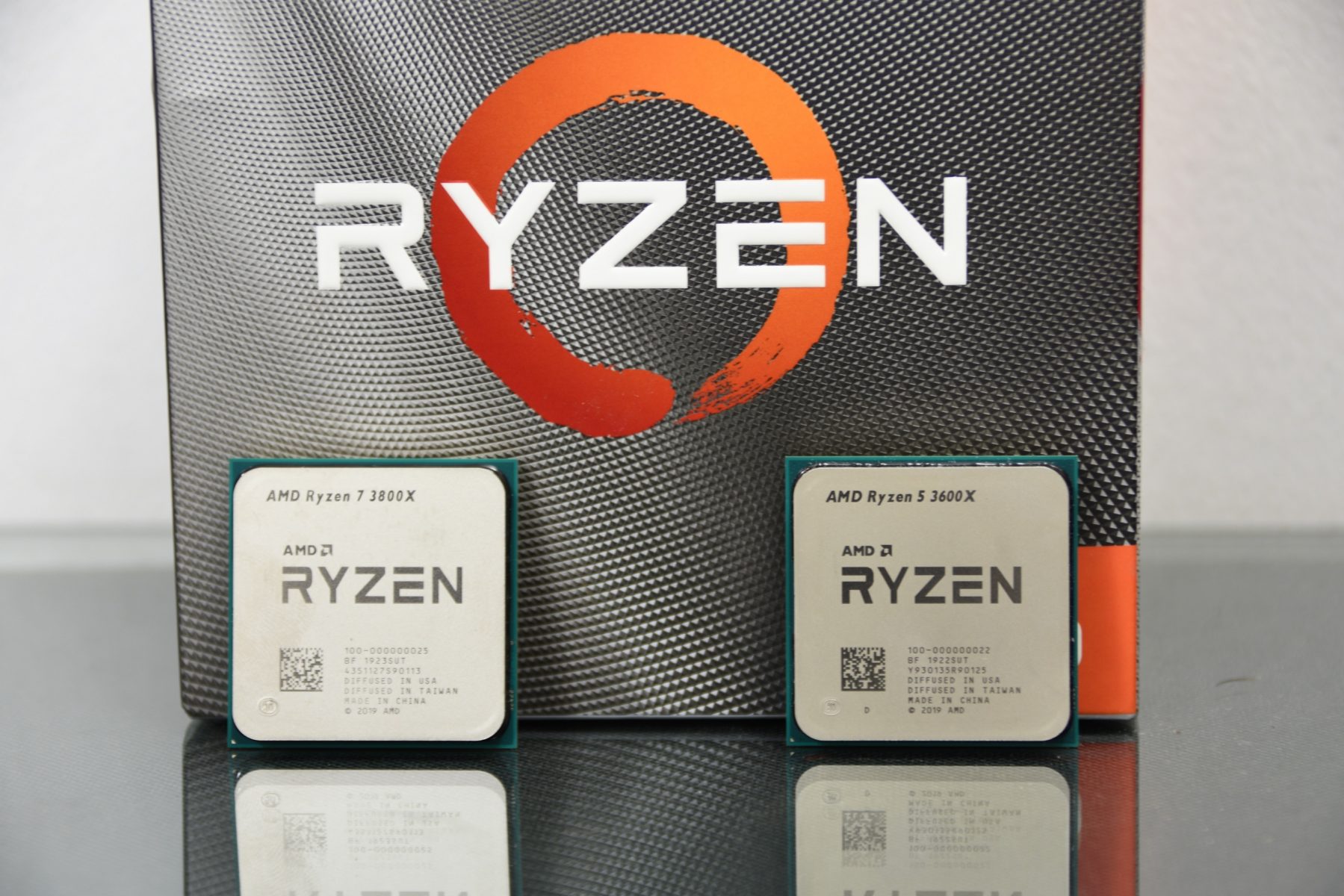Review Ryzen 7 3800X and Ryzen 5 3600X – Knowing more models of this new series of AMD, and thanks to our friends from PC Factory who helped us by providing a Ryzen 7 3800X to our database and together with it to share the results of this processor. Along with this we have also been provided with the Ryzen 5 3600X model, a striking 6-core 12-wire model with a frequency that can reach 4.4GHz. Let’s see how these members behave of what would be the first 7nm processors in the market.
This new generation of Ryzen processors, not only comes manufactured to smaller size (7nm vs 12nm), but also, the change comes in the way of designing these in such a way, that more cores can be incorporated without increasing the size of the die, which would result in a more expensive process and more likely to fail.
That is why they opted for the chiplet model, that is, each specialized unit is in a piece of silicon independent of the other, in this way “it is enough” to add another chip and the cores are increased, or more are added features.
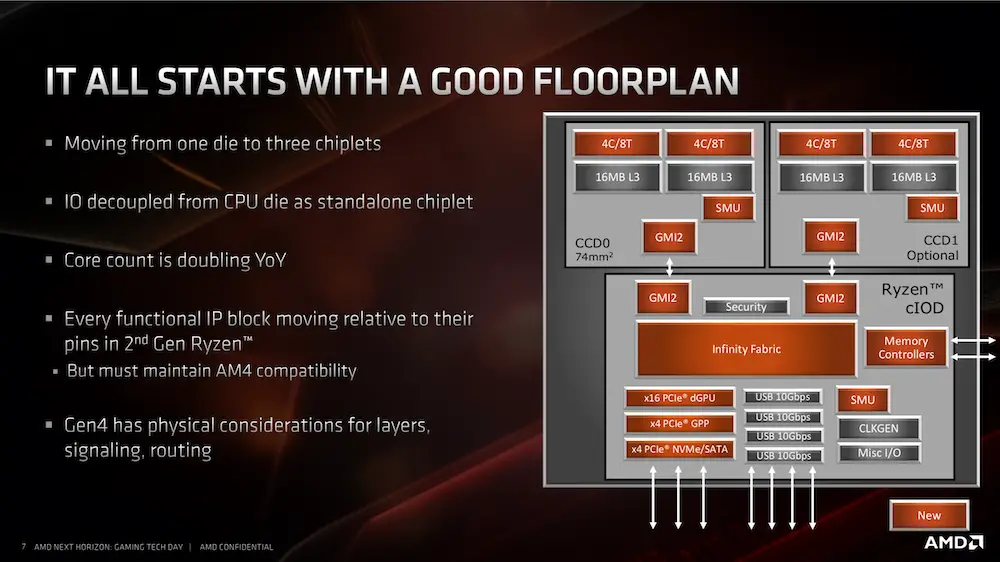
In this way the CPU is modularized, and we saw this with Ryzen Threadripper and Epyc processors for servers, all using the high-speed road called Infinity Fabric 2.0, which will communicate both CCD units through the cIOD.
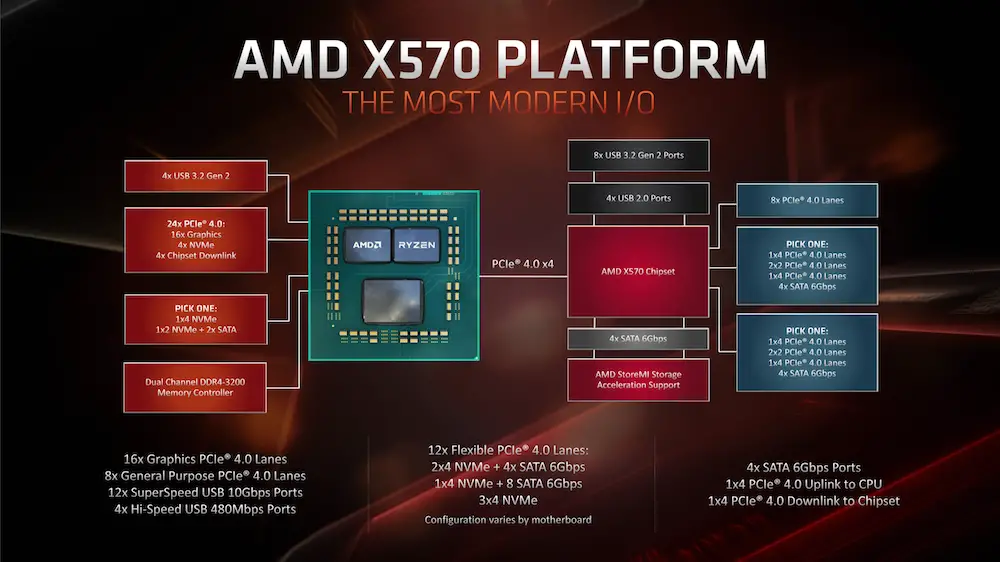
With these new processors, and the new support for PCIe 4.0, it was necessary to update the chipset. For this, the new X570 appears, which grants more SATA and NVMe ports, all through the PCIe 4.0 interface, in addition to 10Gbps USB ports (USB 3.2 Gen2). Obviously the communication with the CPU continues through a PCIe 4.0 x4 link.
Everything is in the routing
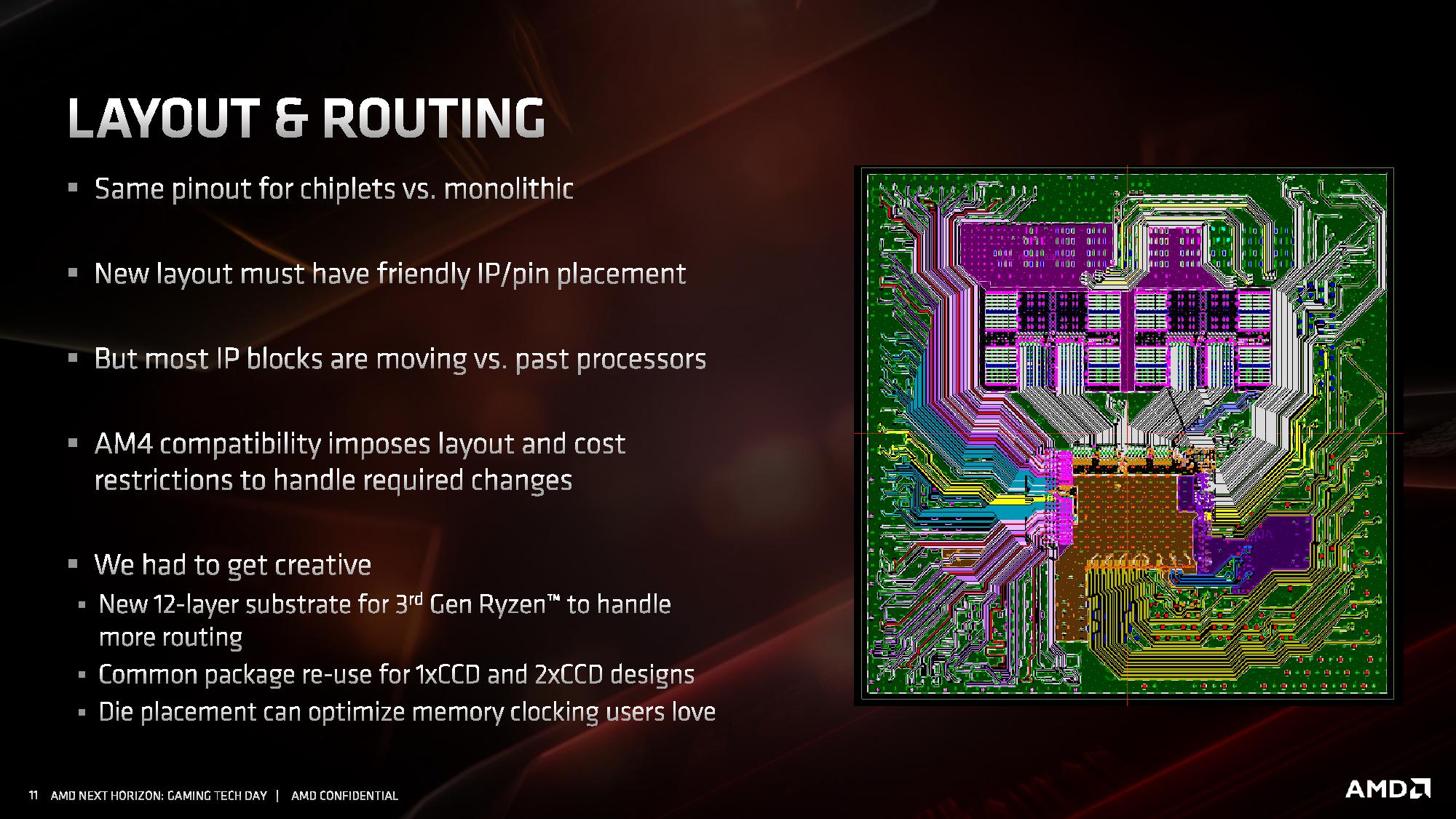
In order to communicate between the cores, all the routing of tracks passes through the IO die, who is finally in charge of communicating the CCDs with each other, and the CPU with the memories and the other components. In order to achieve this, the amount of substrate layers had to be increased to 12.
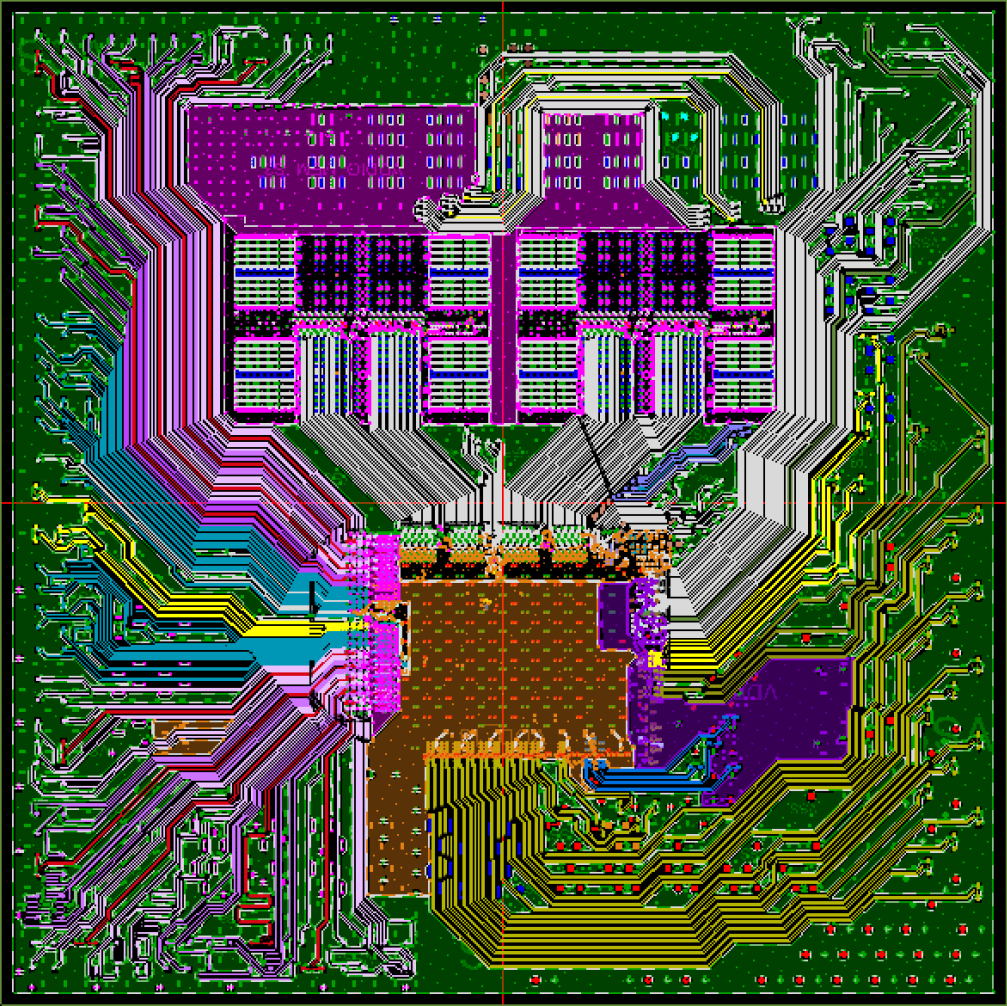
An approach of one of the layers of the CPU, you can see at a glance, the Infinity Fabric lines, which range from CCDs to IO. There is no direct communication between the 2 CCDs.
New design topology
With this new design challenge to incorporate more cores, within the same socket size, the clearest move was to move to a chiplet topology. In this way, they can add more and more cores, just by adding or removing chips from the packing.
The basic unit of Zen2 is the CCD, which consists of 2 CCX (Core Complex) units of 4 cores each, and 16MB of L3 cache (double before). Therefore, each Zen2 CCD unit has a maximum of 8cores / 16Threads, and 32MB of L3 cache.
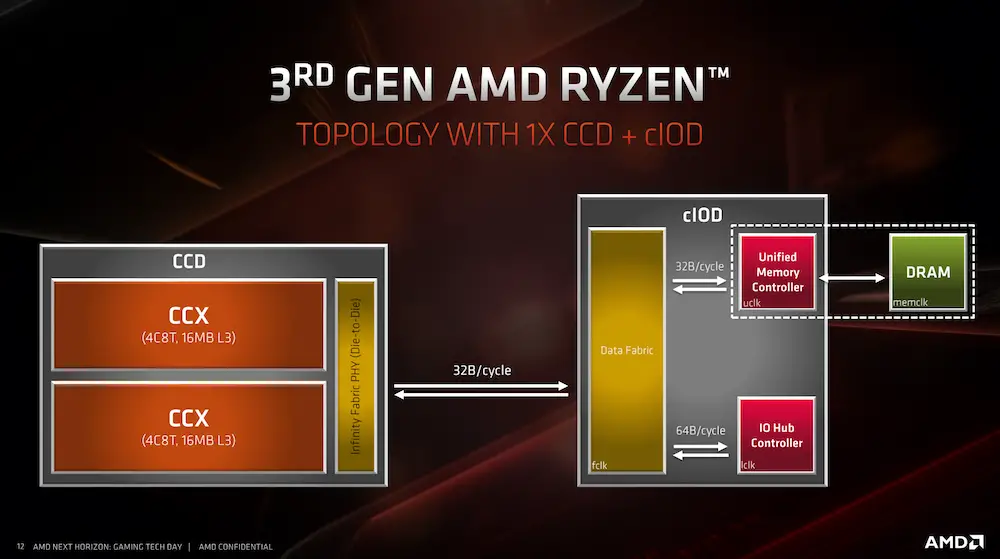
This topology is what we see in the Ryzen 5 and Ryzen 7 third generation processors. Since the maximum number of cores is 8. Recall that the communication with the IO is through the Infinity Fabric, and it is this chipset that is in charge of communicating with the rest of the components.
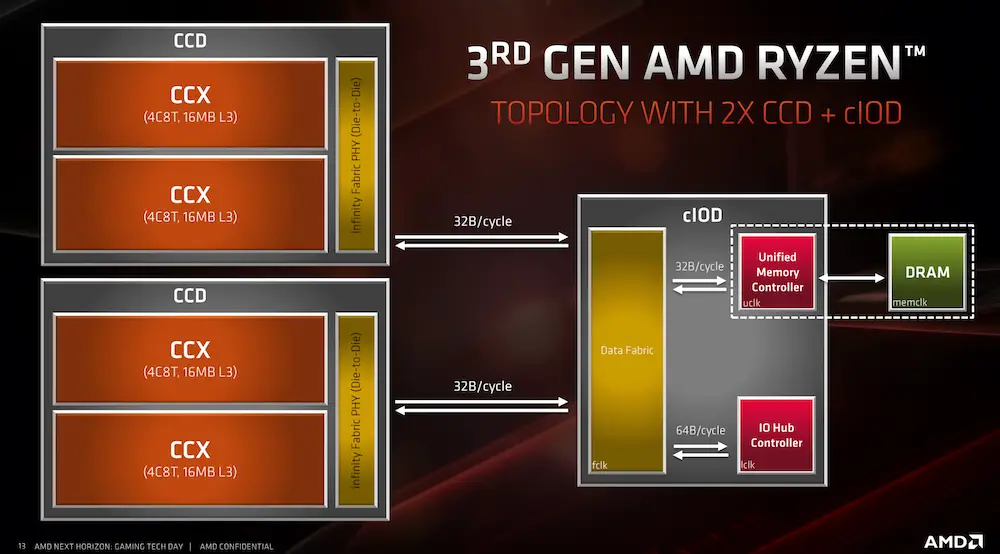
When you want to go beyond the 8 cores, it is necessary to add one more CCD, with this the maximum will be 16 cores / 32 Threads and 64MB of L3 cache. This is why a processor like the Ryzen 9 3950X (16C / 32T) is possible.
Internal improvements (Better cache and new stages)
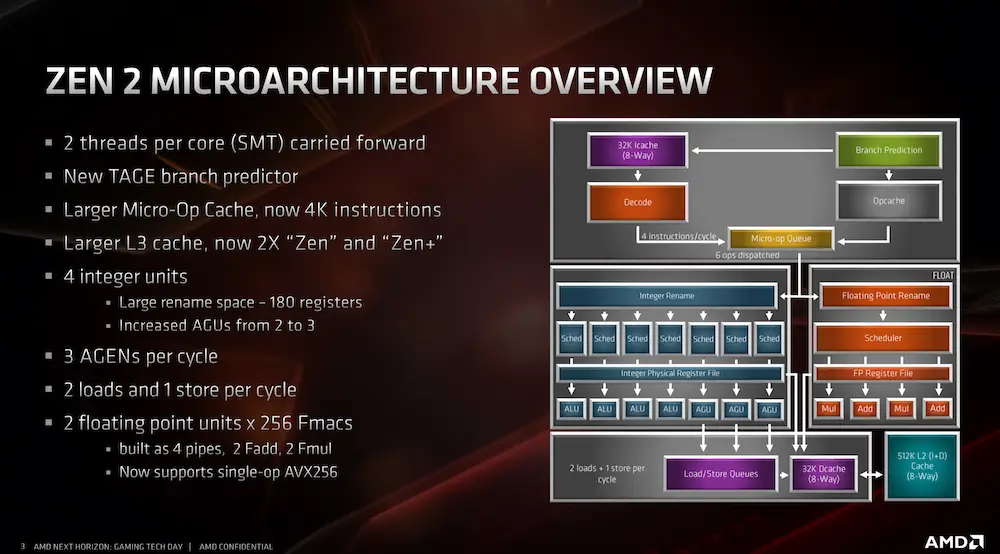
At a high level, the kernel looks a lot like what we already know about Zen. The highlights of the Zen 2 design include a different L2 branch predictor known as a TAGE predictor, a duplication of cache memory micro-op, a doubling of the L3 cache, an increase in integer resources, an increase in load / storage resources and support for single-operation AVX-256 (or AVX2).
Despite all these changes, AMD has stated that there is no frequency penalty when using AVX2, depending on its frequency platform with energy recognition.
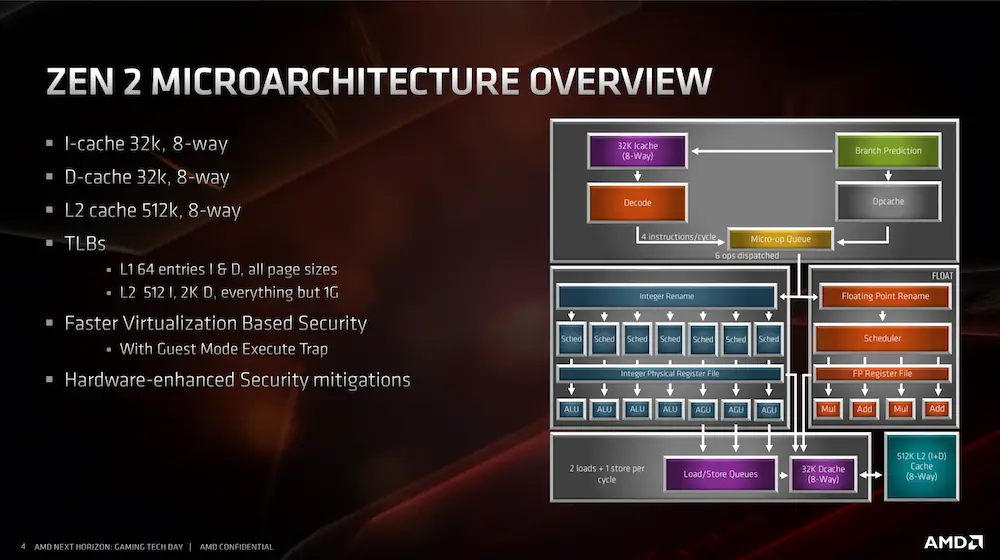
AMD has also made adjustments to the cache system, the most notable is the L1 instruction cache, which has been halved to 32 kB, but the associativity has doubled. The L1 data cache and L2 cache have not changed, however, translation buffers (TLB) have increased their compatibility. AMD also states that it has added greater virtualization support with respect to security, which helps enable future functions.
Taking a quick look, it’s easy to say that doubling the microoperative cache will offer a significant improvement in the IPC in a number of scenarios, and combining that with an increase in load / storage resources will help drive further instructions. The double L3 cache will help in specific workloads, as would the single AVX2 operation support, but the improved branch predictor will also show an increase in raw performance. In summary, for a paper analysis, the AMD + 15% improvement in CPI seems to be a very reasonable number to promote.
Security: Something that stays with Zen 2
One of the important issues of the past year, and that is maintained throughout 2019, is the security in the CPUs, specifically those based on X86 architecture. Since its design and microcode, it allowed malicious people to be able to perform tasks remotely, or execute malicious code to extract data, without one noticing.
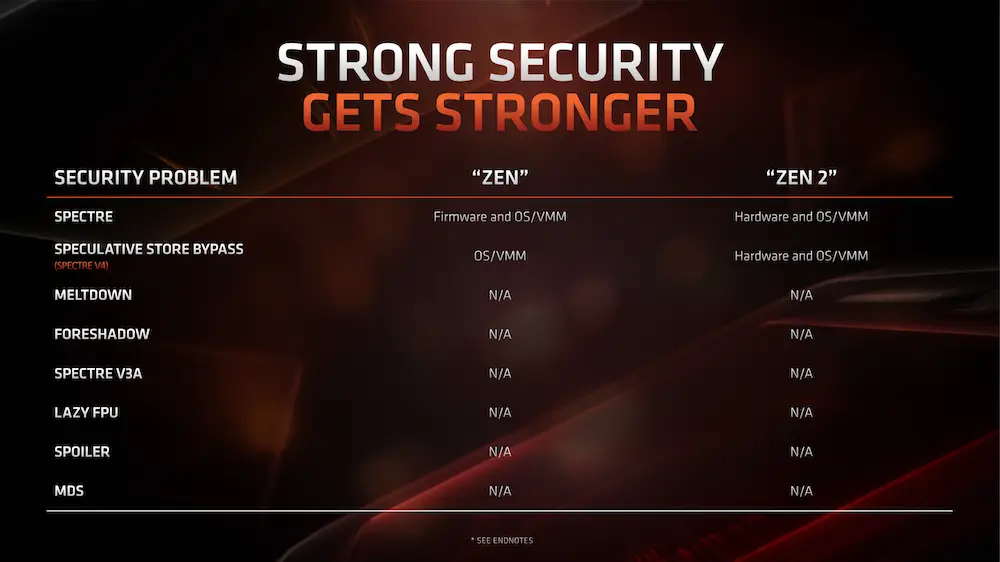
Like all processors based on the Zen architecture, these new Zen 2s have mitigations at the hardware level and also at the operating system level already implemented by Microsoft. Therefore, they would not be affected by the recent and better known security problems in the CPUs, which on the Intel side, has become a great headache.
Memory Support and Overclock
Another point that this new family of Ryzen processors improves, is the support and overclock in the memories. Something that in the current generations of Ryzen processors caused many headaches. Well, with this new Zen 2, and the improved I / O chip, using high frequency memories will not be a problem, nor will it be to take them to the highest frequencies.

In fact, they promise that frequencies of up to 5100MHz can be achieved in the memories (that allow it, clearly) and all this by air. This could be achieved, in part by the aforementioned, of separating the chips in the CPU and providing a better memory controller in the IO chipset, in conjunction with the X570 chipset. In addition to that with Infinity Fabric 2.0, dividers are implemented automatically, to maintain the stability of the system as a whole.
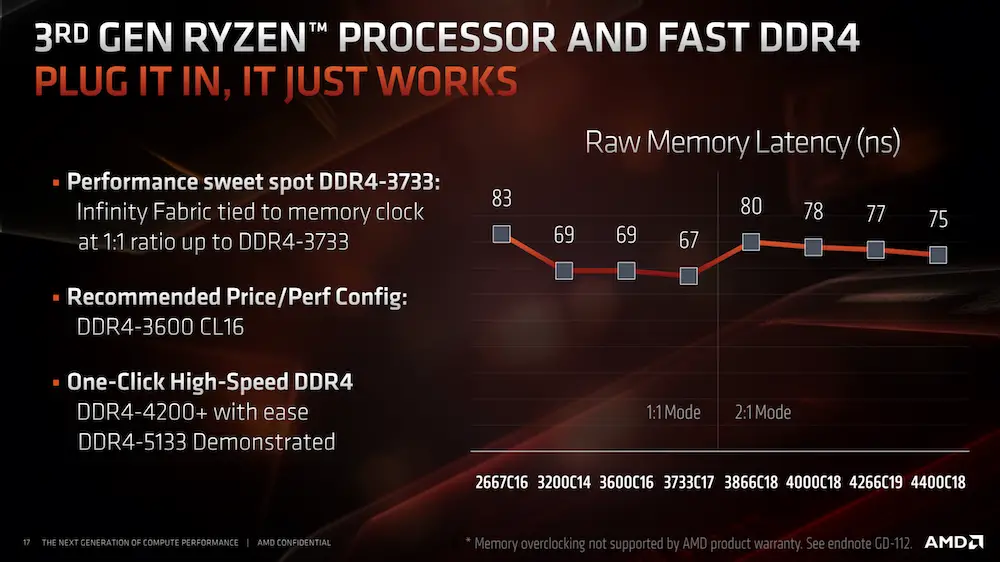
Whenever we install quick memories in our new system, Infinity Fabric will operate at a 1: 1 ratio with the frequency of the memories, this until a frequency of 3733MHz is reached. When we exceed that frequency, IF will automatically enter a 2: 1 ratio mode, this means that it will operate at half the frequency of the memory.
This obviously implies that the latency will increase a little, and the performance will be impacted by approximately 1-2%, but this had to be done in order to maintain the stability of the IF, and in the process to achieve higher frequencies in the memories.
The Ryzen 3000 family of processors
Let’s get to know a little about these new 3rd generation processors.
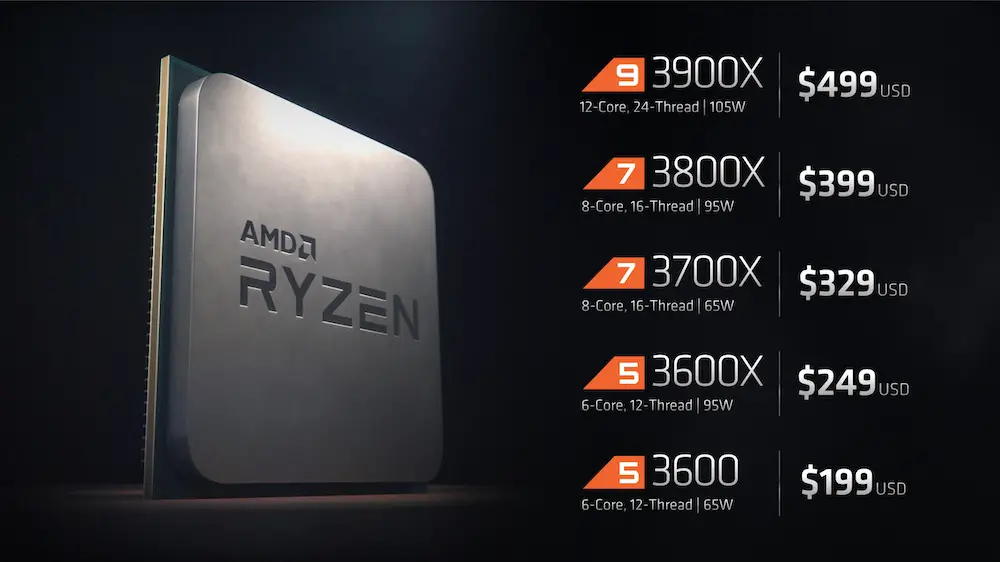
The prices remain very attractive, something that we liked and attracted attention, since being a new way of manufacturing and production, they should lower costs, but by incorporating more cores they tend to rise. With this AMD continues in its line of offering more cores at an attractive price to the consumer.
Windows 10 and its improvements
Together with all the new features of these processors, AMD together with Microsoft, implemented improvements at the operating system level, in this way a problem that was occurring in certain current scenarios was corrected, where the Windows scheduler does not know how to redirect the priorities of execution of the tasks, which led to a greater latency, and consequently, a decrease in the overall performance.
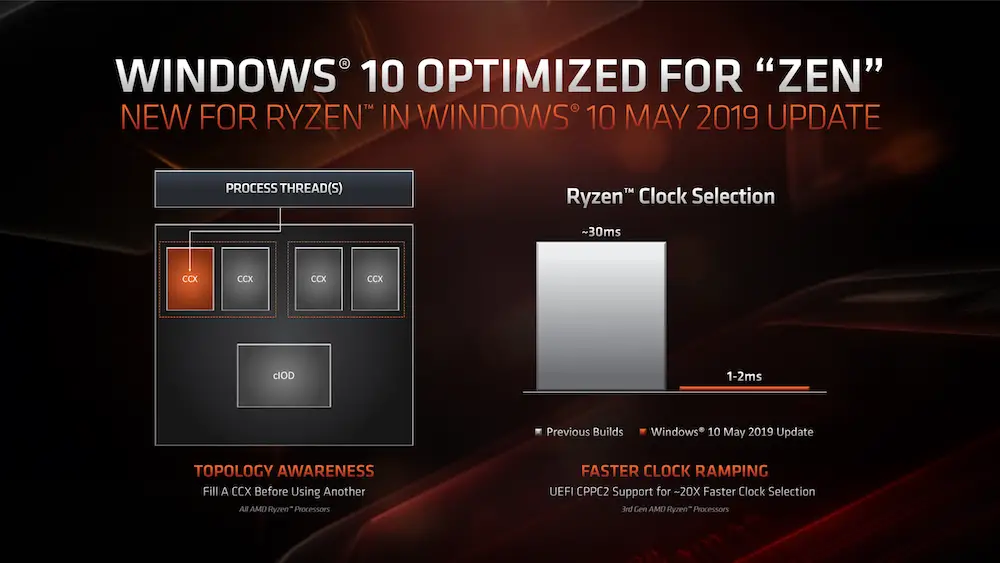
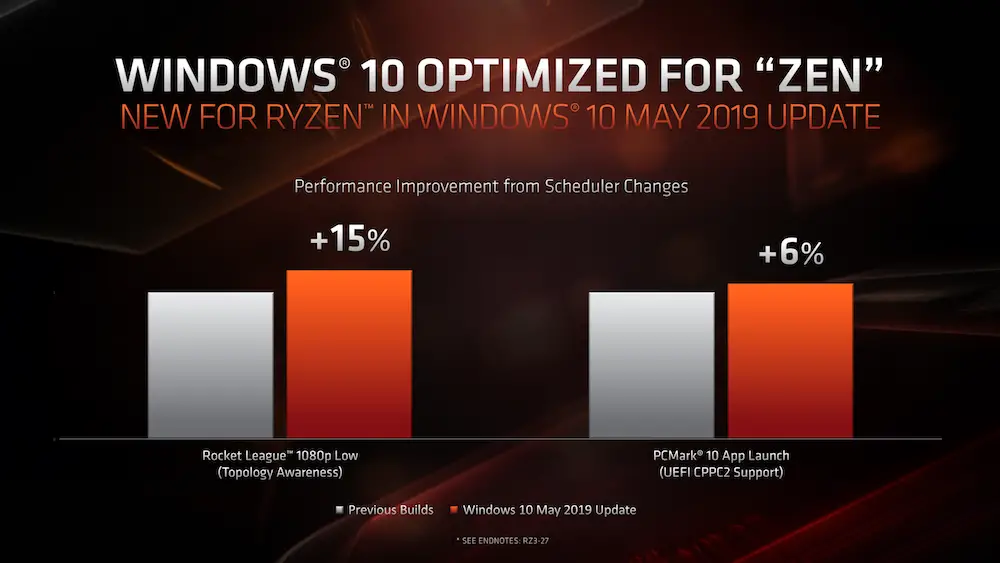
With the so-called Topology Awareness in Windows and CPPC2 in the BIOS, AMD together with Microsoft improved response times to frequency changes in Windows, and also in the load distribution of each CCX. With this patch of improvements, now a CCX must be completely full of tasks, to just skip instructions to another CCX.
This could generate up to 15% improvement in performance, and 6% improvement in response time in applications. This is available with the May update of Windows 10, but is only activated with X570 boards.
The whole family
Finally, this is the new family of 3rd Generation Ryzen processors, from the “modest” Ryzen with Radeon Vega Graphics, to the top of the Ryzen 9 3900X line.
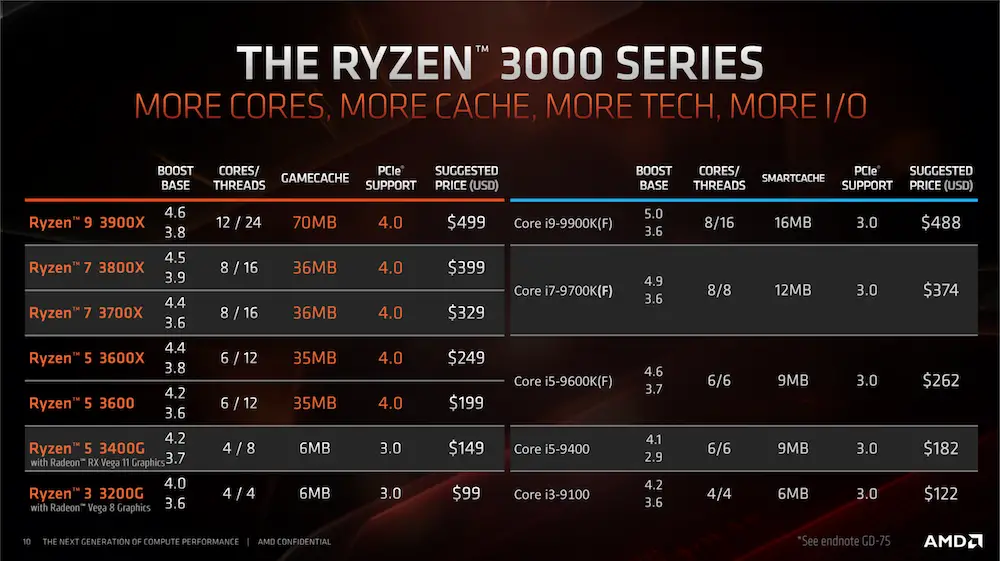
A whole range of options, from processors with integrated graphics, up to 12 cores and 24 threads with frequencies reaching 4600MHz.
Specs.
| specs | AMD Ryzen 9 3900X | AMD Ryzen 7 3800X | AMD Ryzen 7 3700X | AMD Ryzen 5 3600X | AMD Ryzen 5 3600 | AMD Ryzen 7 2700X | Intel Core i9 9900K | Intel Core i7 9700K |
|---|---|---|---|---|---|---|---|---|
| Fabrication process | 7nm | 7nm | 7nm | 7nm | 7nm | 12nm | 14nm | 14nm |
| Cores | 12 | 8 | 8 | 6 | 6 | 8 | 8 | 8 |
| Threads | 24 | 16 | 16 | 12 | 12 | 16 | 16 | 8 |
| Freq. Base | 3.8 GHz | 3.9GHz | 3.6 GHz | 3.8GHz | 3.6 GHz | 3.7 GHz | 3.6 GHz | 3.6 GHz |
| Freq. Max | 4.6 GHz | 4.5GHz | 4.4 GHz | 4.4GHz | 4.2 GHz | 4.3 GHz | 5.0 GHz | 4.9 GHz |
| L2 cache | 6MB | 4MB | 4MB | 3MB | 3MB | 4MB | 2MB | 2MB |
| L3 cache | 64MB | 32MB | 32MB | 32MB | 32MB | 16MB | 16MB | 12MB |
| TDP | 105W | 105W | 65W | 95W | 65W | 105W | 95W | 95W |
| Sist. Refrigeration | Wraith Prism with RGB LED | Wraith Prism with RGB LED | Wraith Prism with RGB LED | Wraith Stealth | Wraith Stealth | Wraith Prism with RGB LED | N / A | N / A |
| USD price | $ 499 | $ 329 | $ 199 | $ 254 | $ 485 | $ 365 | ||
| CLP price | $ 445,000 | $ 389,990 | $ 315,900 | $ 229,990 | $ 175,000 | $ 250,000 | $ 439,900 | $ 349,900 |
First look.
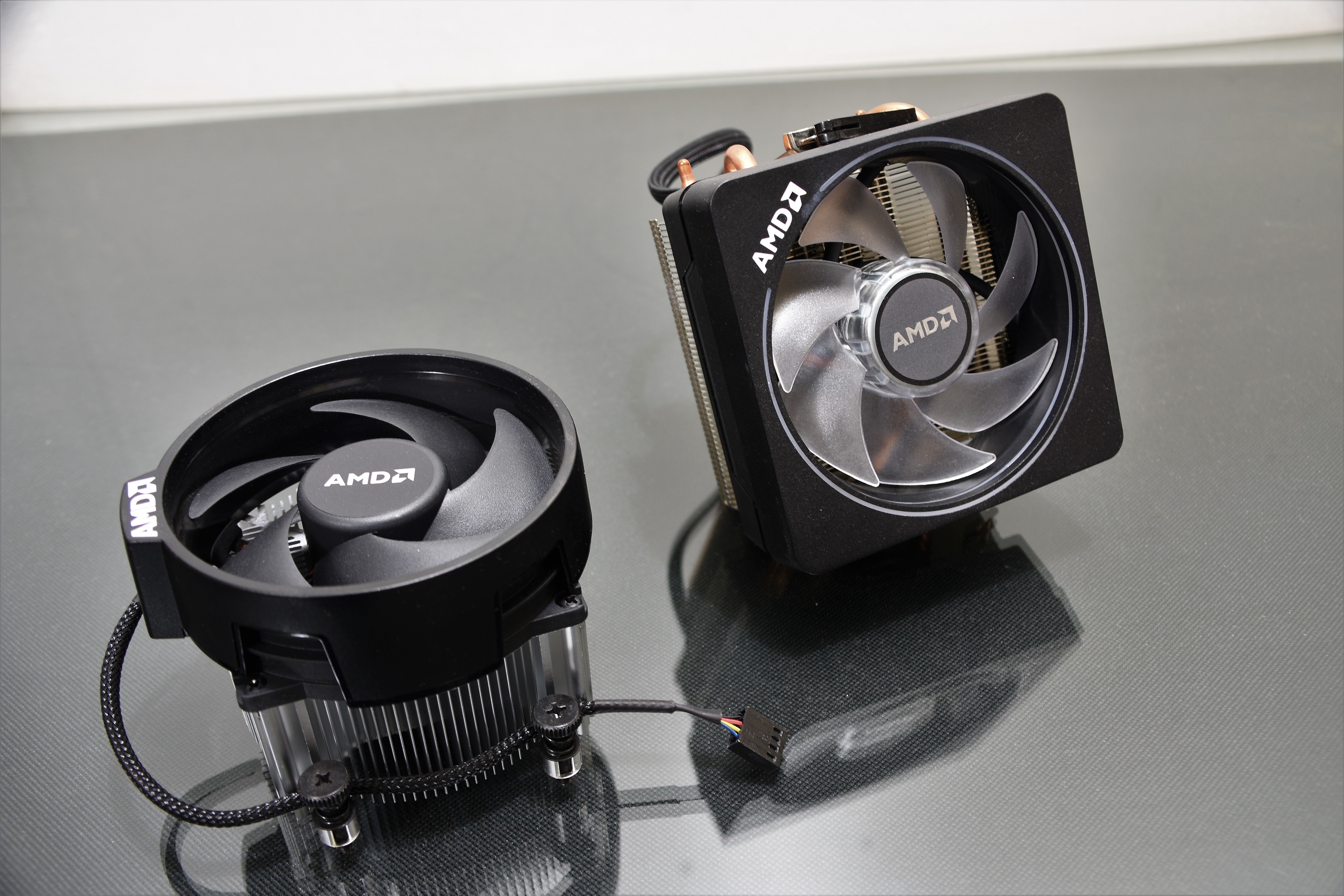
The default cooling system: On the left the AMD Wraith Spire as a solution for the AMD Ryzen 5 3600X and on the right the attractive AMD Wraith Prism for the Ryzen 7 3800X.
Testing and Methodology Platform.
| Test Platform | |
|---|---|
| Processor | – AMD Ryzen 7 3800X – AMD Ryzen 5 3600X |
| Motherboard | – GIGABYTE X570 AORUS MASTER |
| Memories | – G. Skill TridentZ 3200MHz 2x8GB |
| Refrigeration | – AMD Wraith Prism – AMD Wraith Spire |
| Graphics card | – NVIDIA GTX 1070 Ti 8GB |
| Power supply | – Corsair RM1000X |
| Storage | – SAMSUNG 960PRO 512GB M.2 |
| Monitor | – ASUS MG28UQ |
- Windows 10 Pro x64 operating system [Update 1903].
- The tests were performed in an environment with a temperature of approximately 25 ° C.
- The platform was used without a cabinet.
- The drivers used for NVIDIA graphics cards were: ForceWare 430.86 WHQL
- The resolutions of the synthetic tests are the default ones for each of the benchmarks.
2D tests
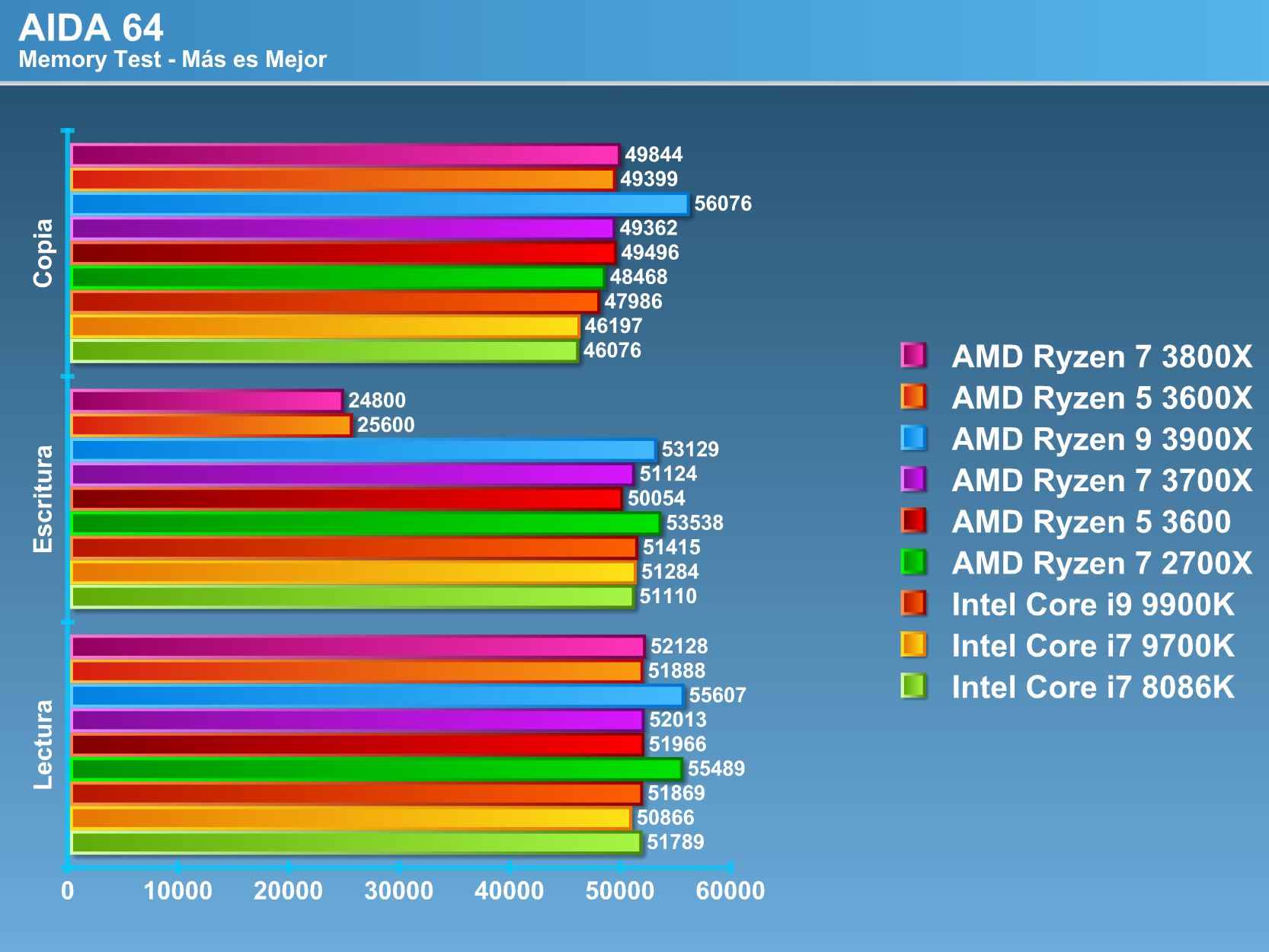
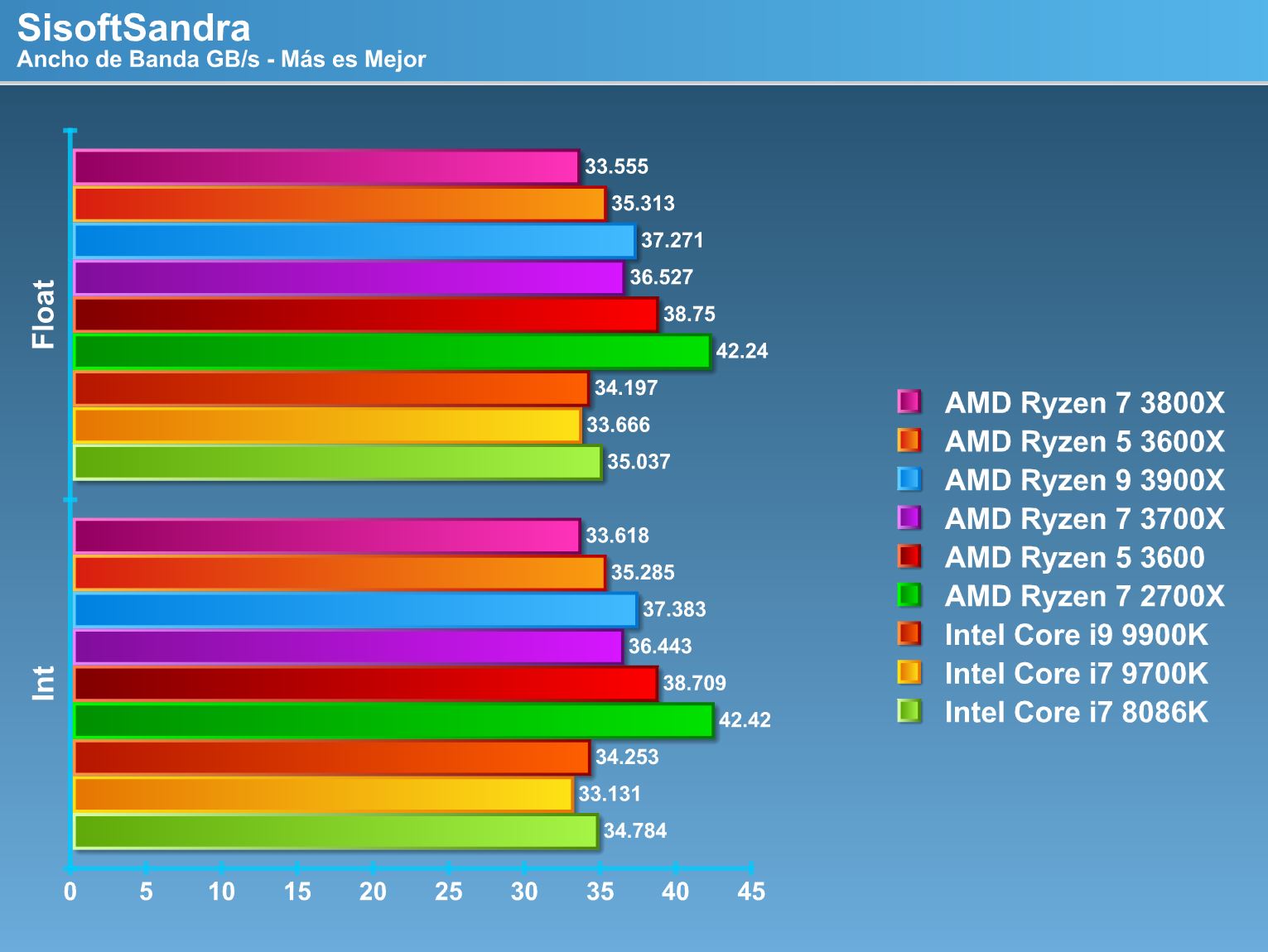
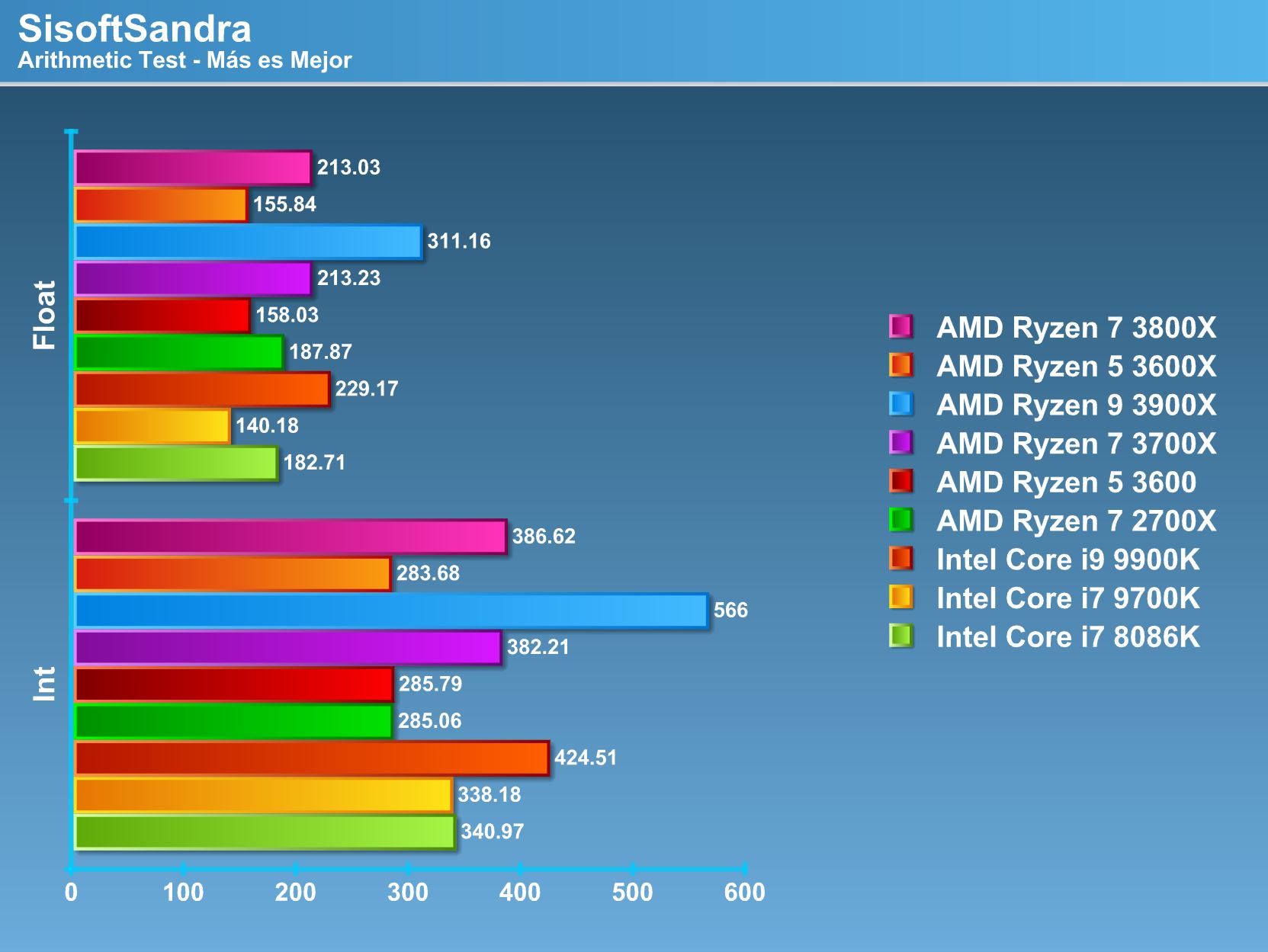
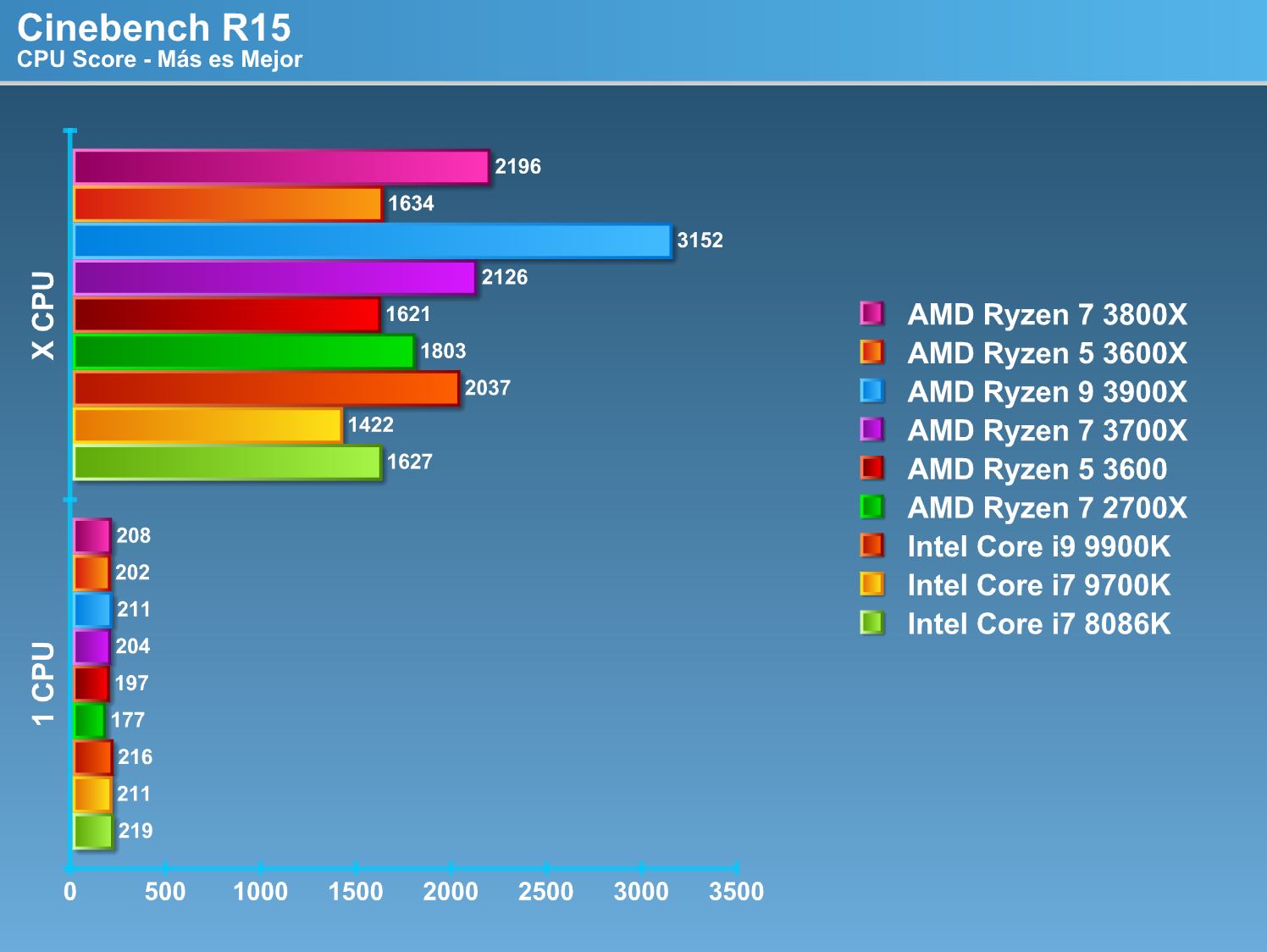
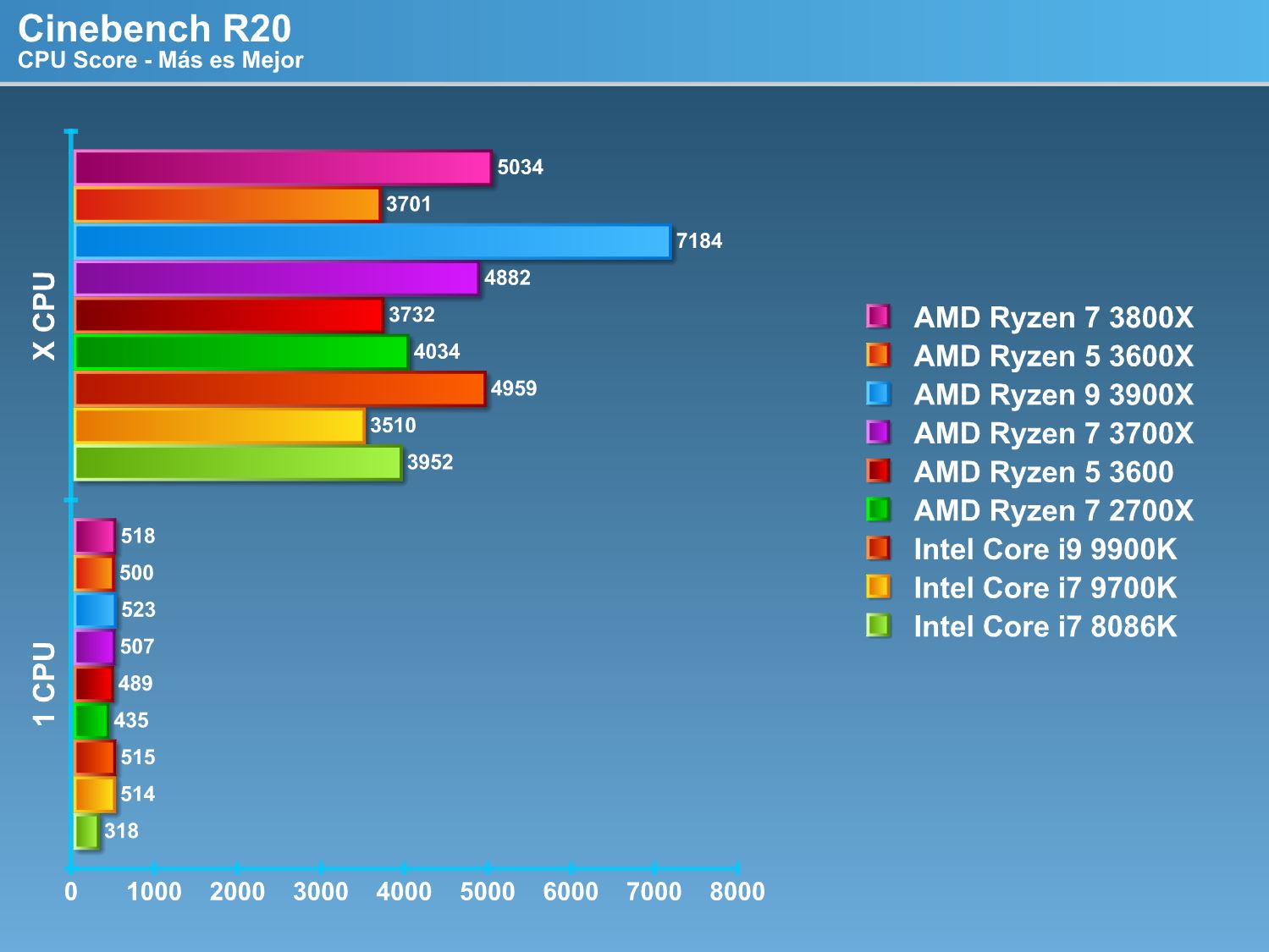
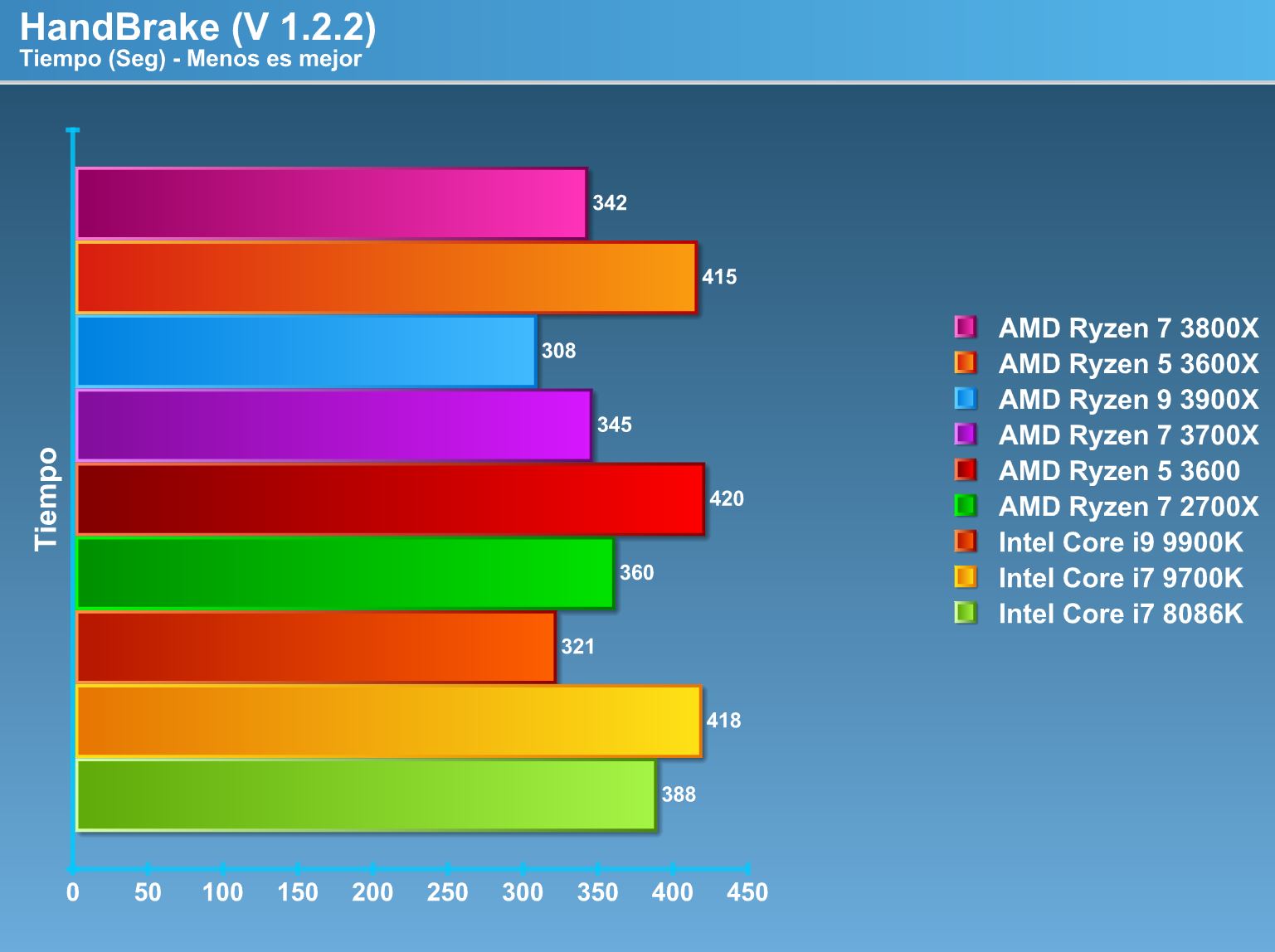
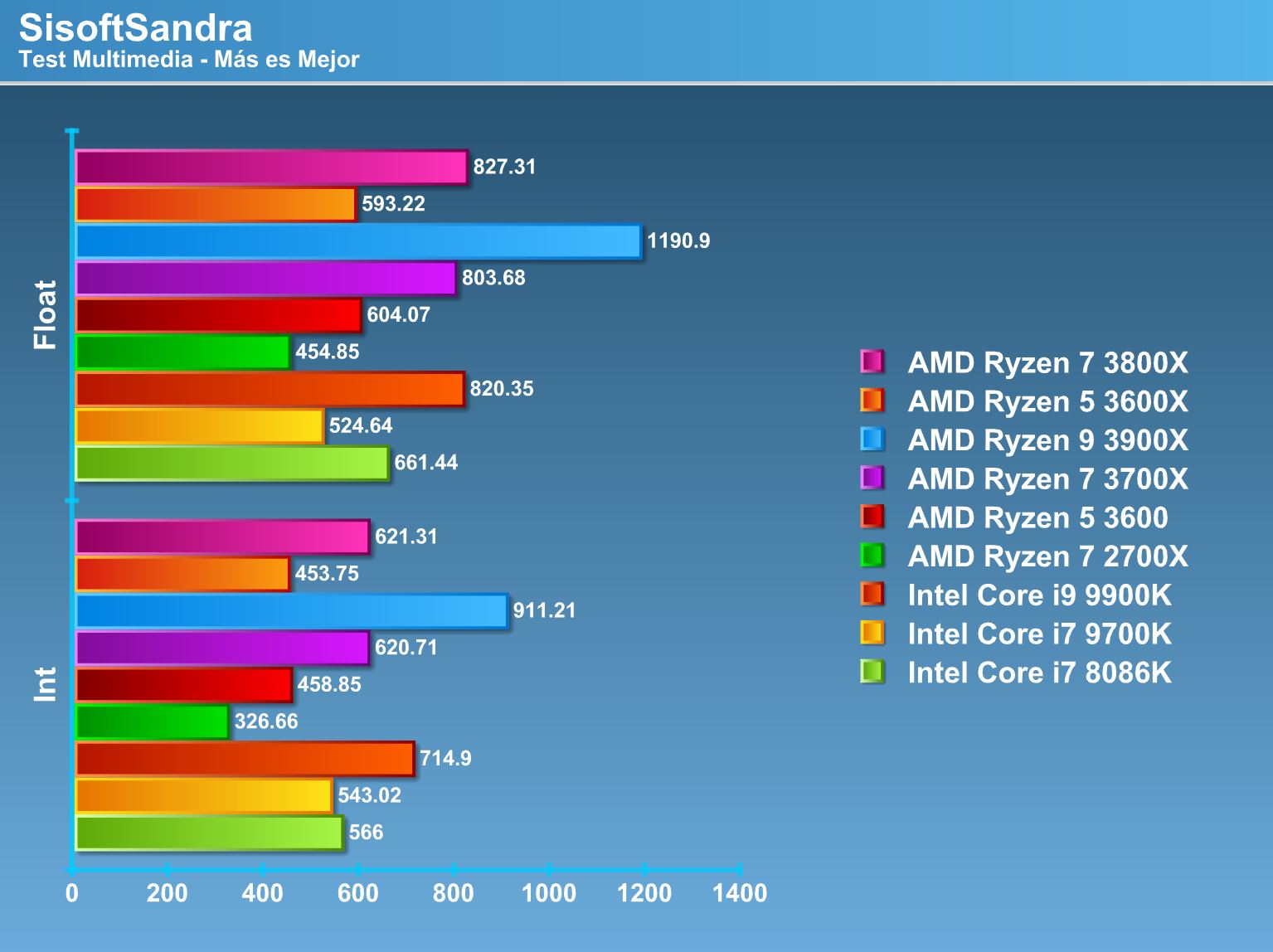
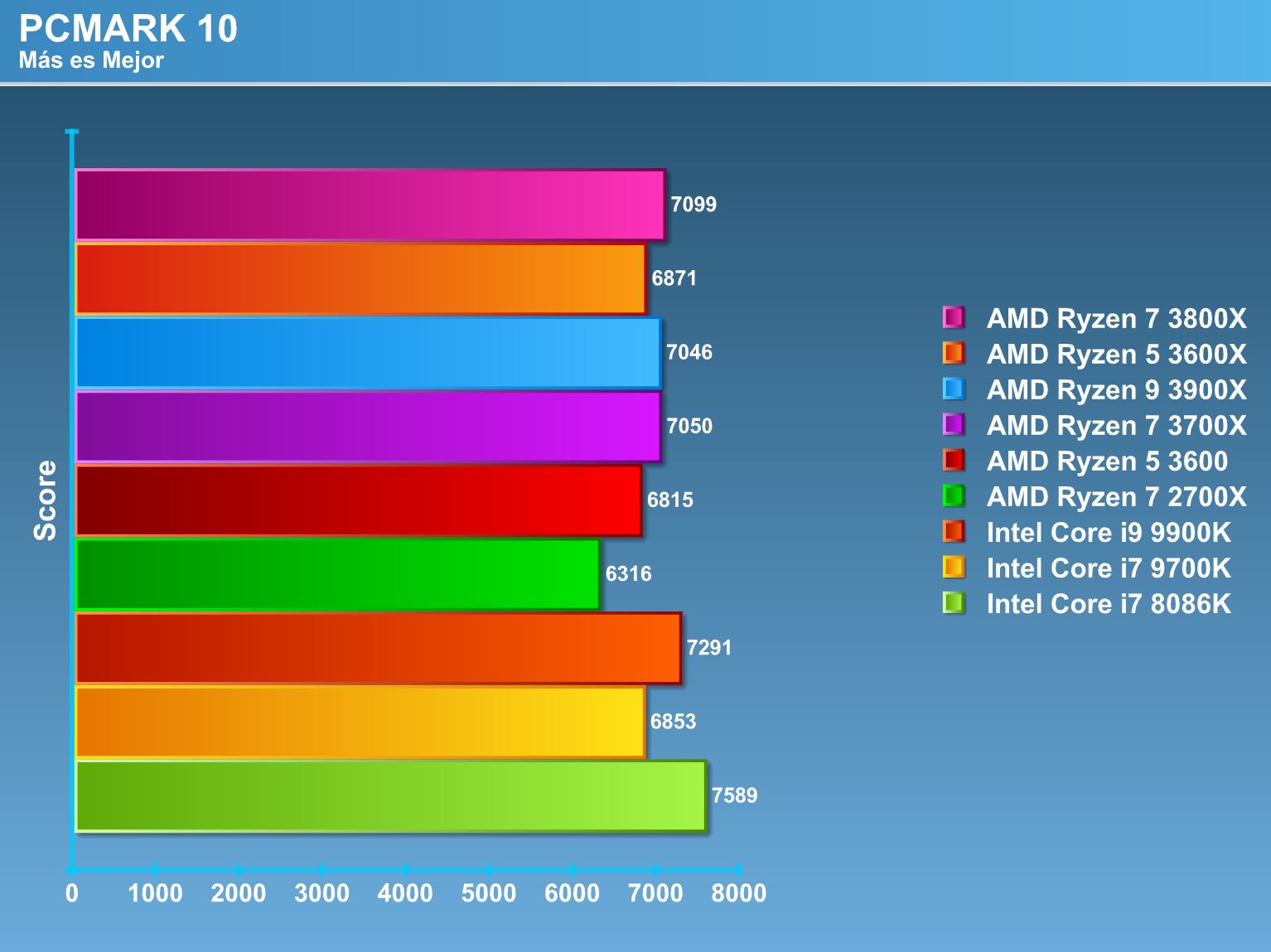
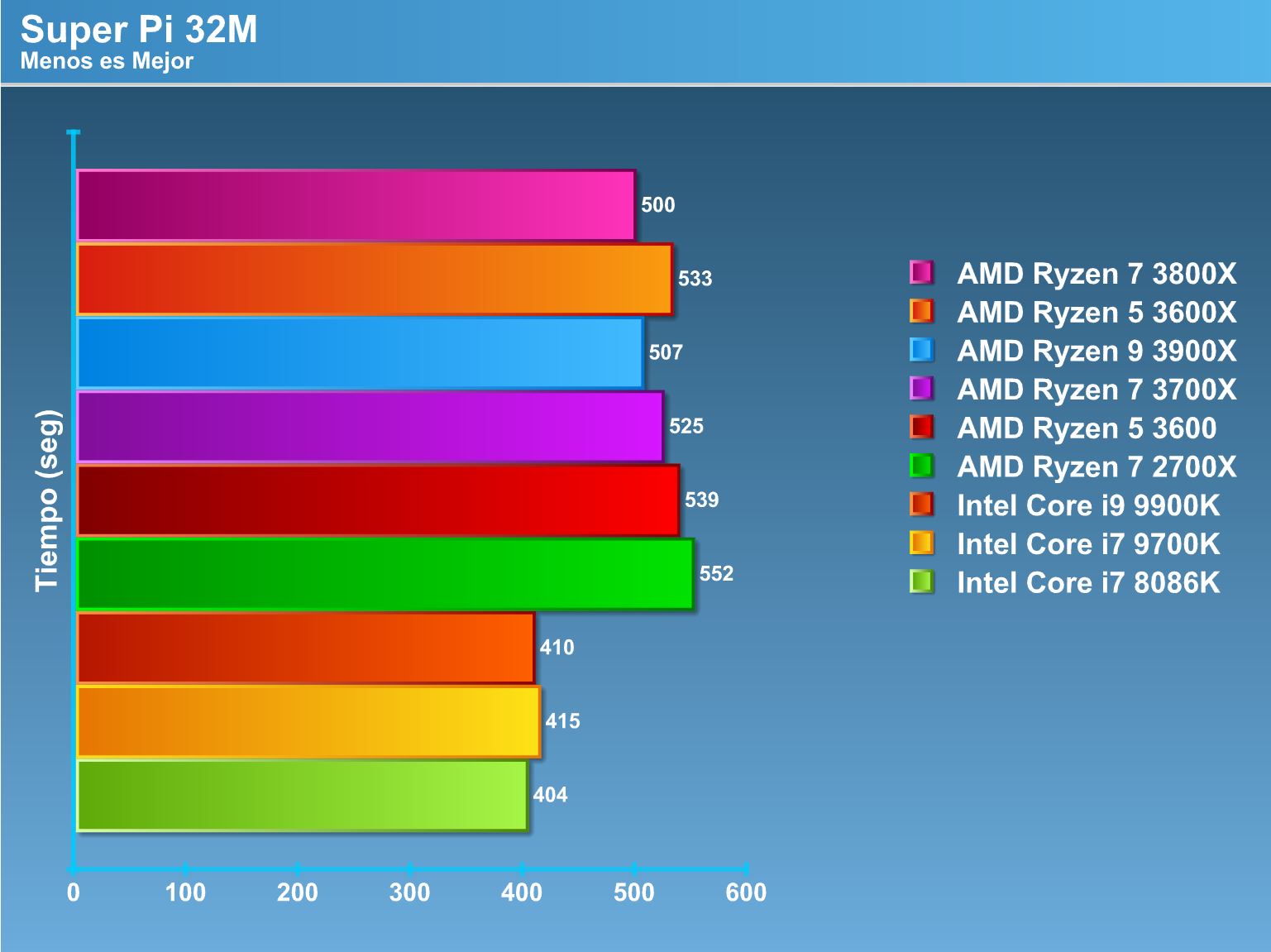
3D tests

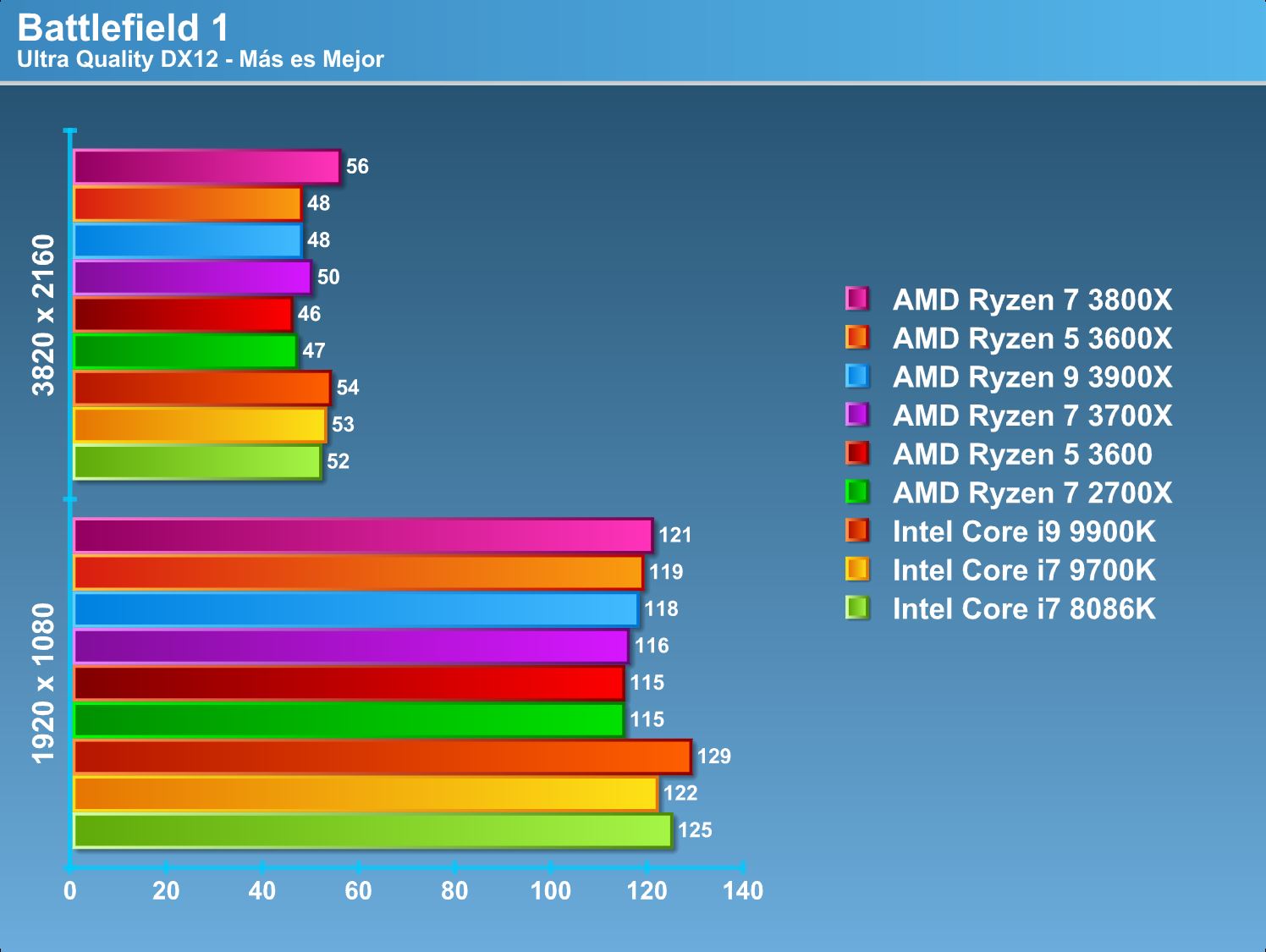
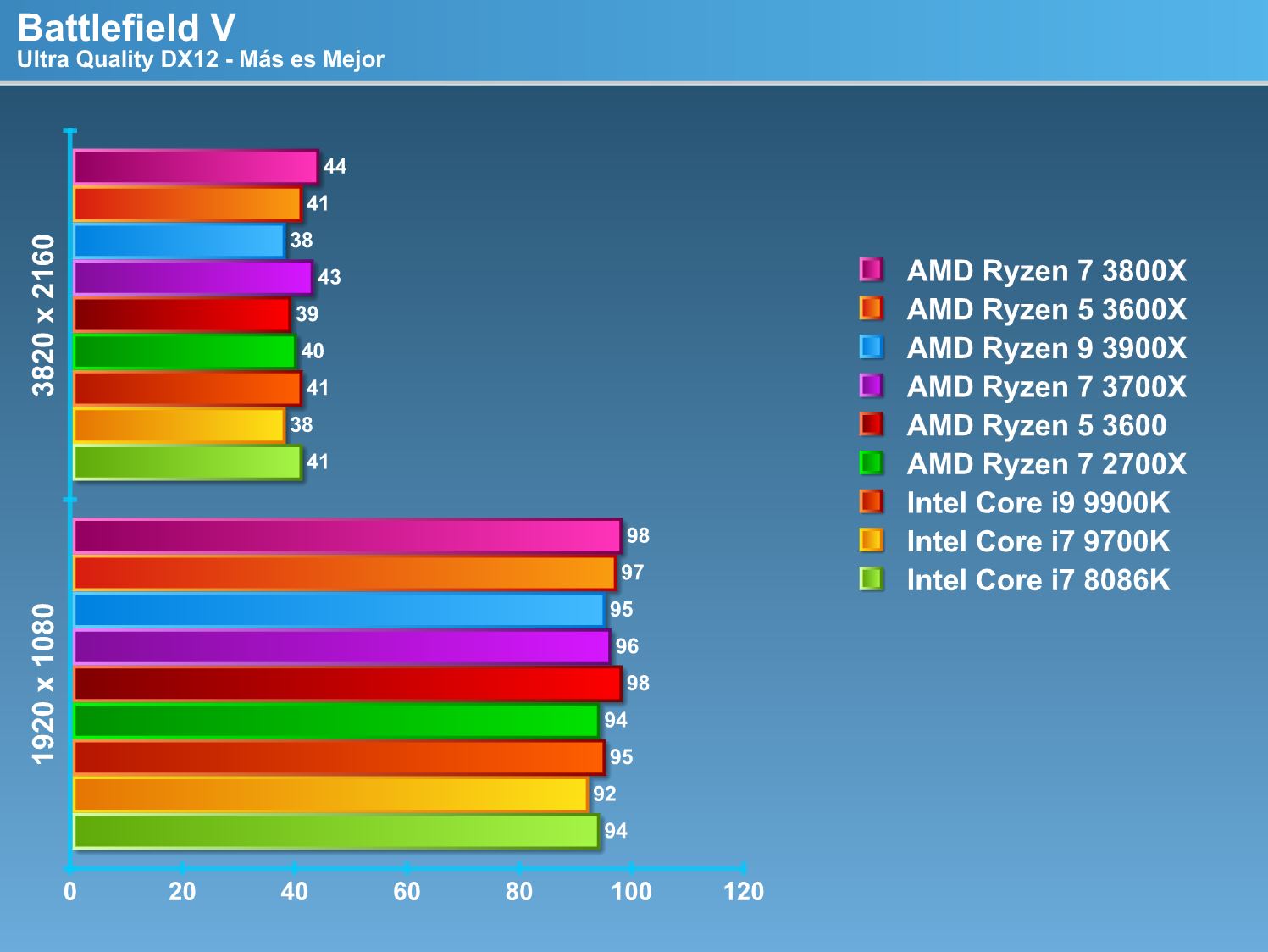
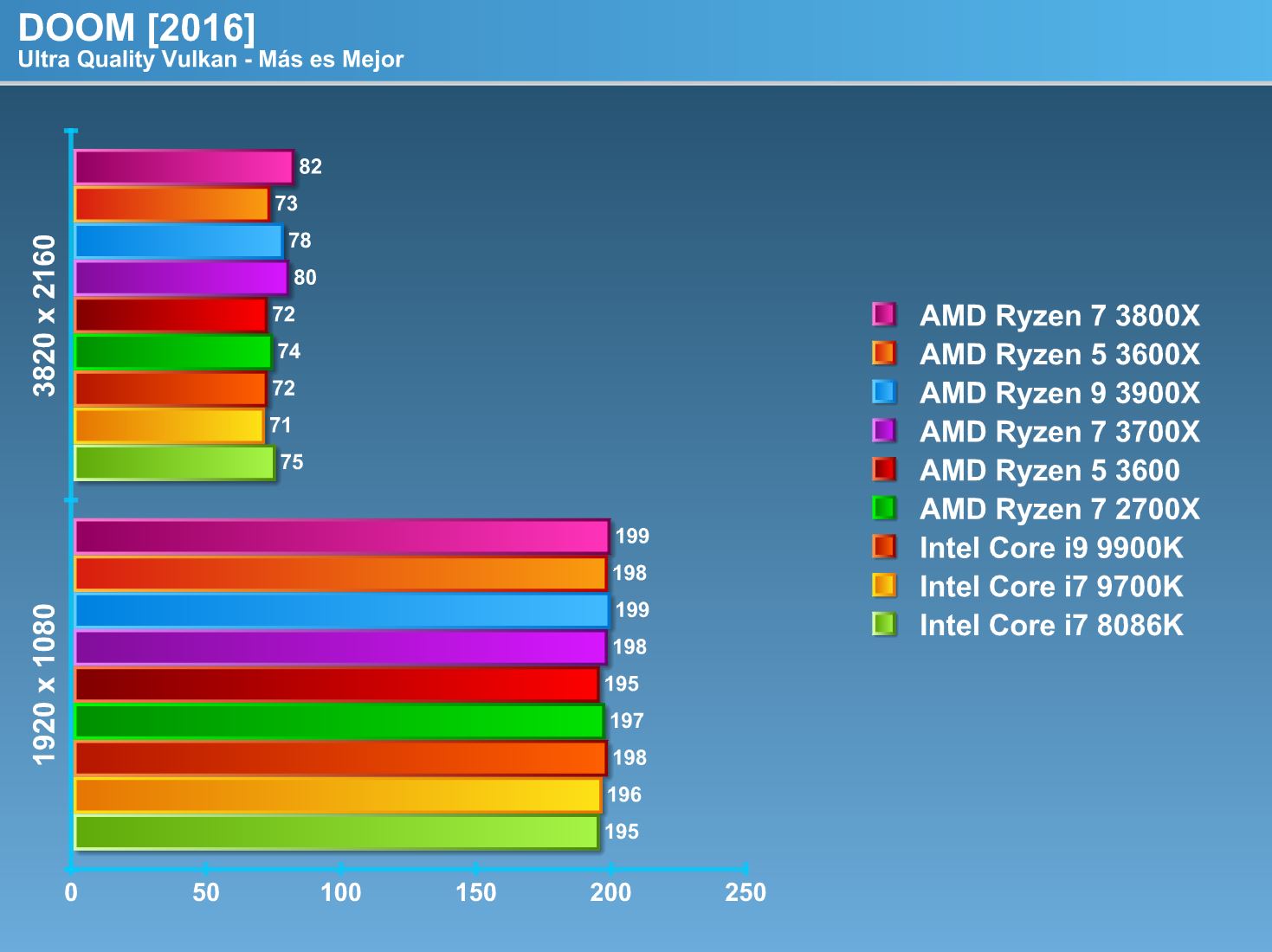

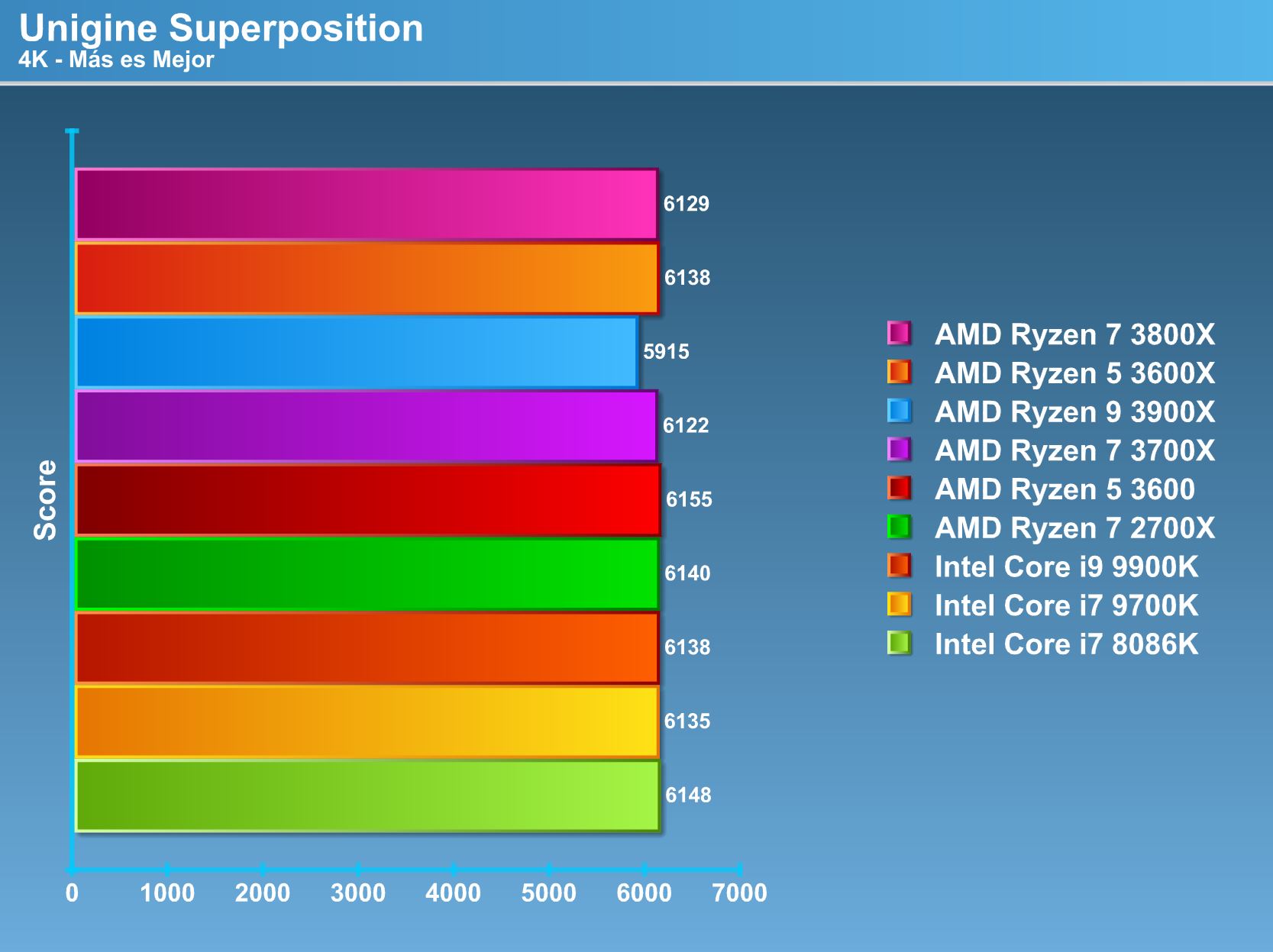
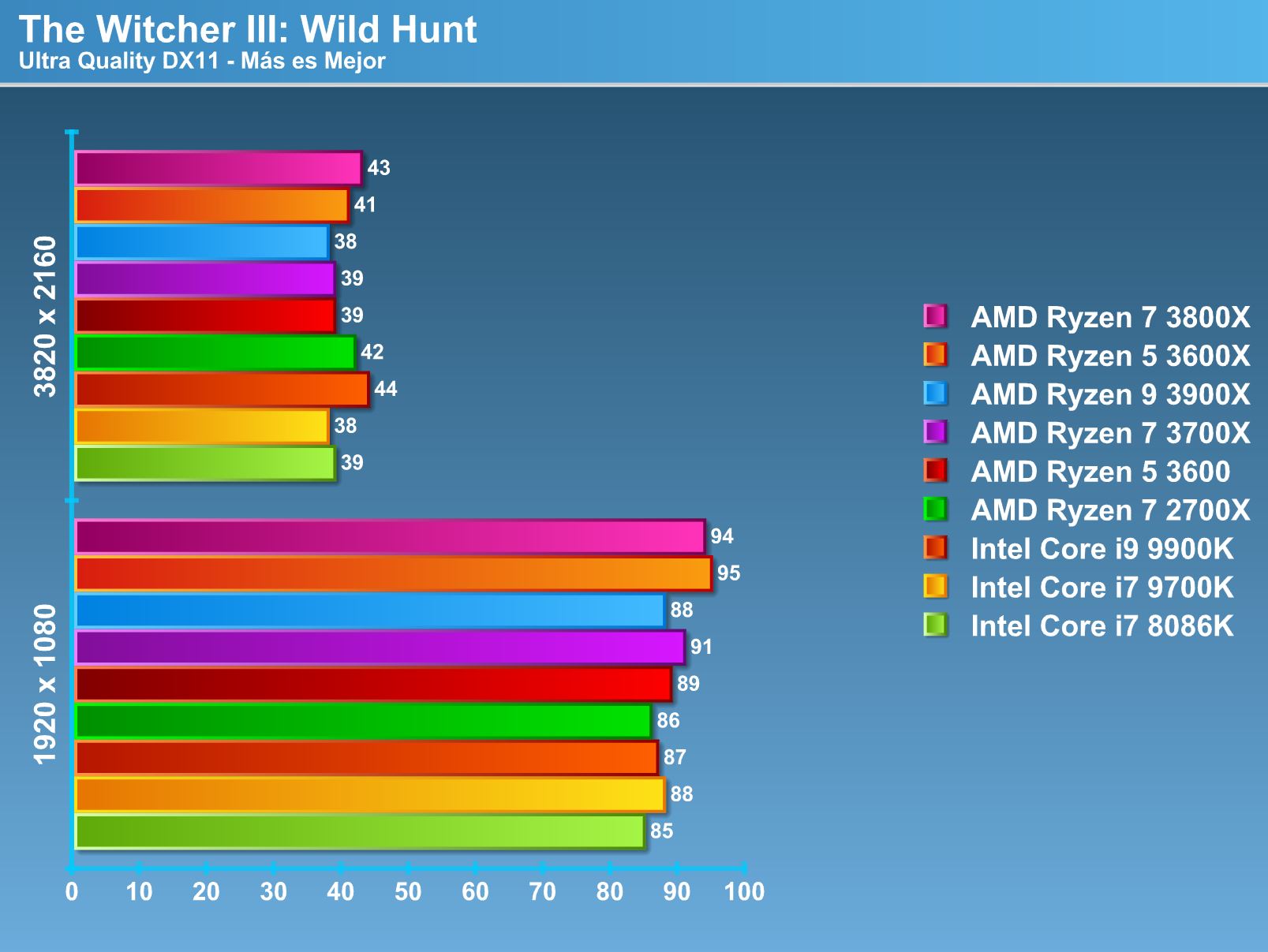
Consumption and temperature.
Factors such as temperature and consumption, although they become second-line aspects regarding the decision to choose our processor, can become as important as the performance of the processor. Excessive consumptions and extreme temperatures could disenchant any user when experiencing one of these two problems, however AMD has managed to find a balance under these factors, although in the output of the Ryzen 3000 series it has been somewhat affected in these aspects, since High voltage values have generated a considerable increase in temperature, this in some versions of AGESA, directly affecting the Ryzen 7 3700X and R7 3800X in greater proportion, however we have seen in the version of AGESA 1.0.0.3ABB that has been achieved Decrease the temperature increase.
We leave the results both in consumption with temperature.
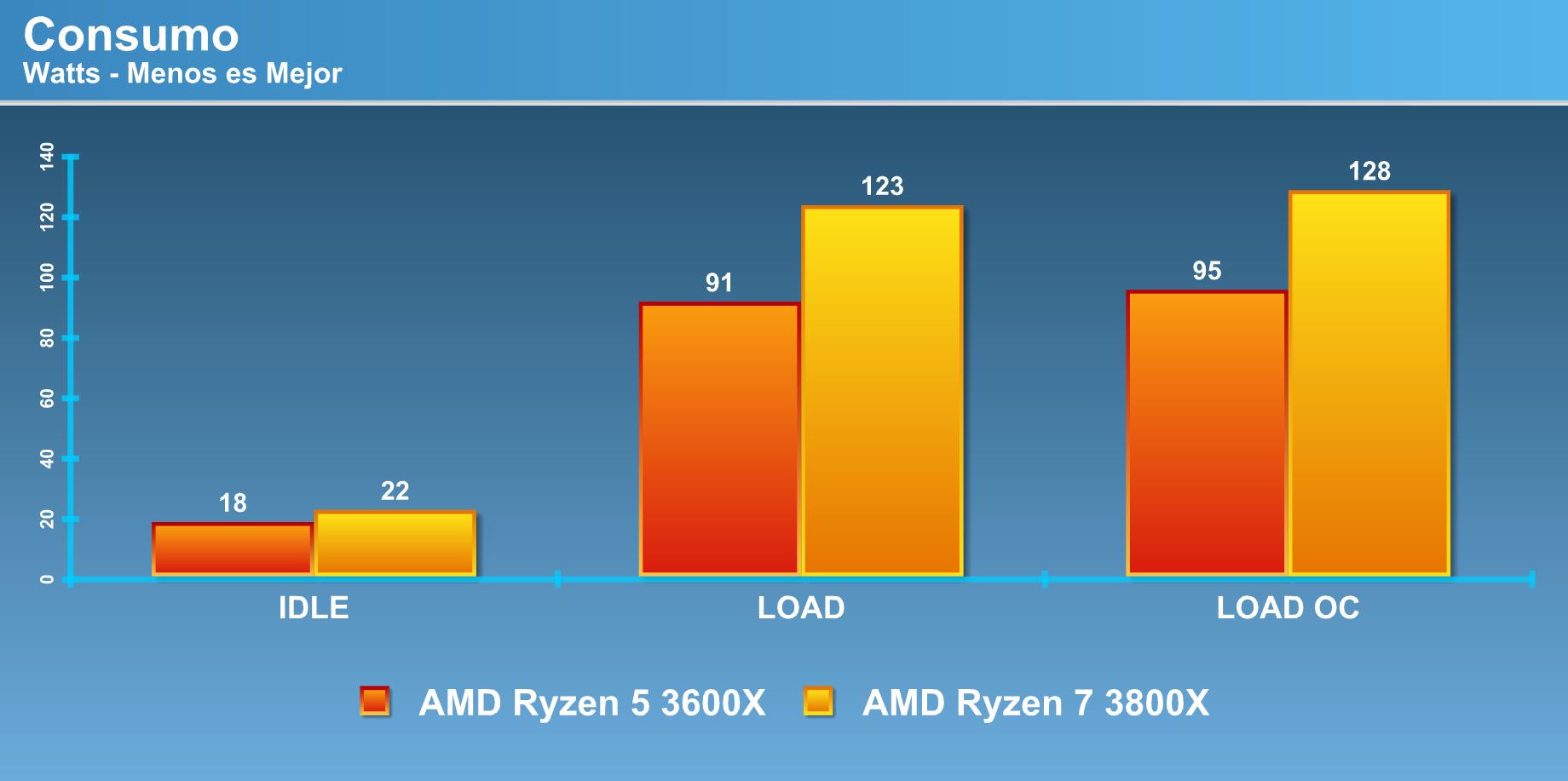
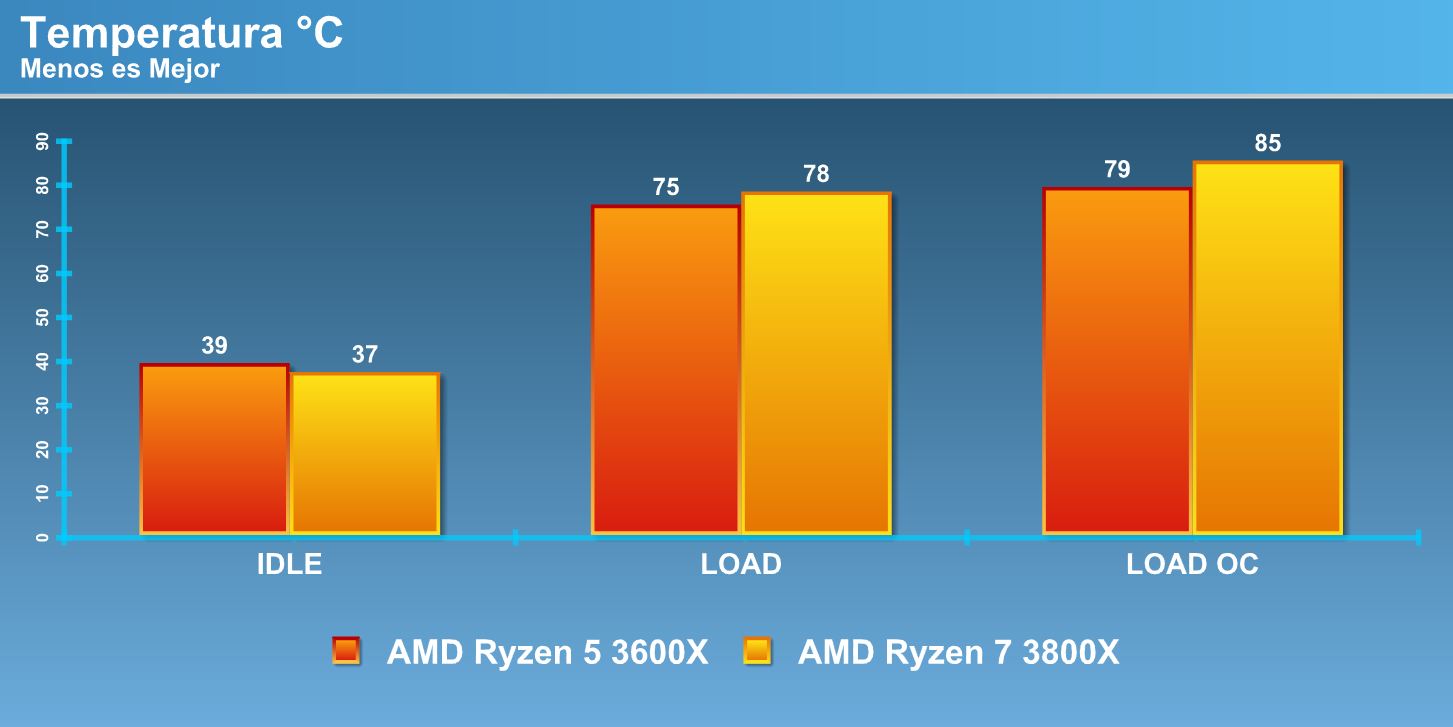
Overclocking.
Taking full advantage of these processors, overclocking values were adjusted for all 4.2 GHz cores with a voltage of 1.4V in both processors.
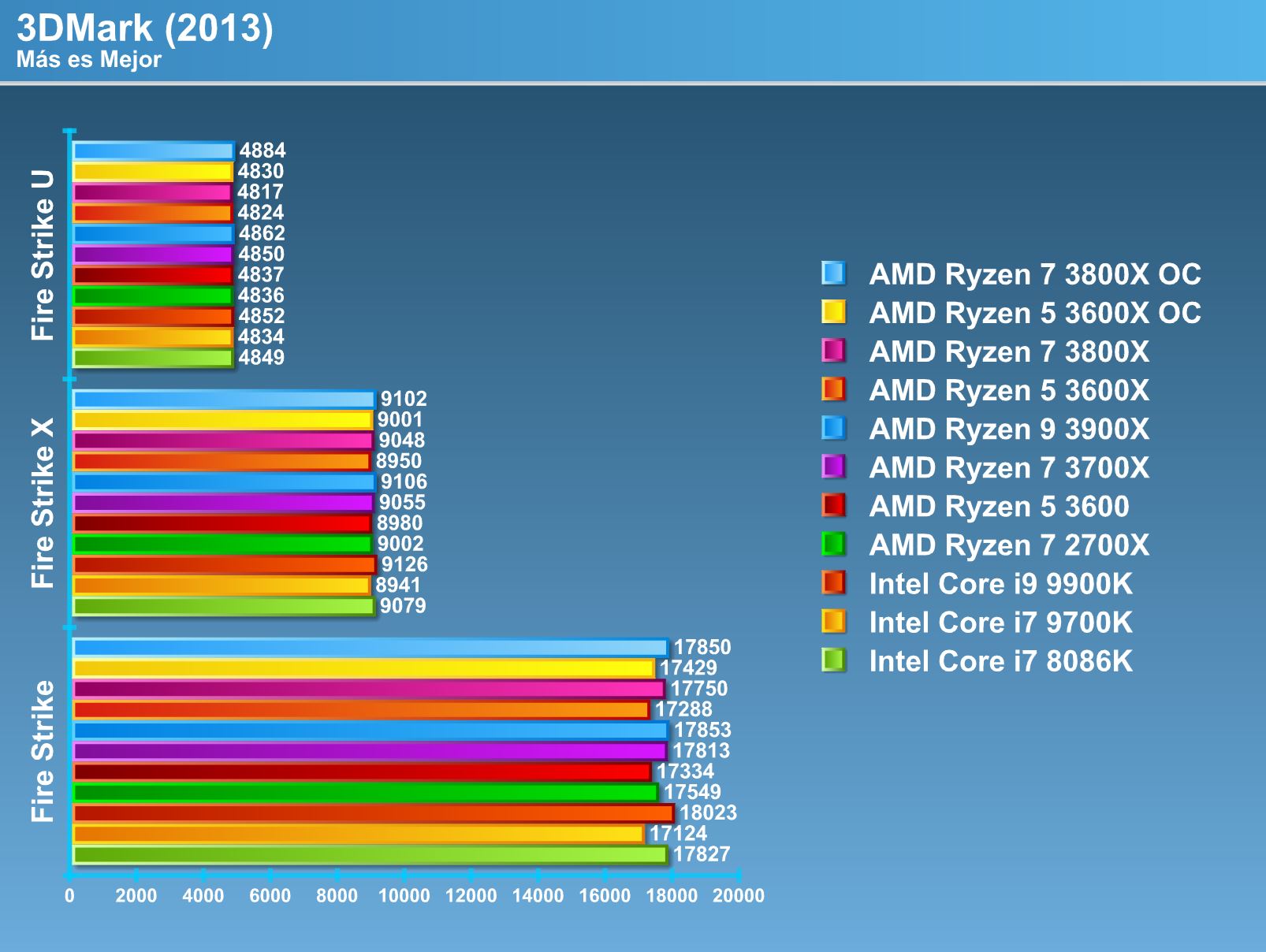
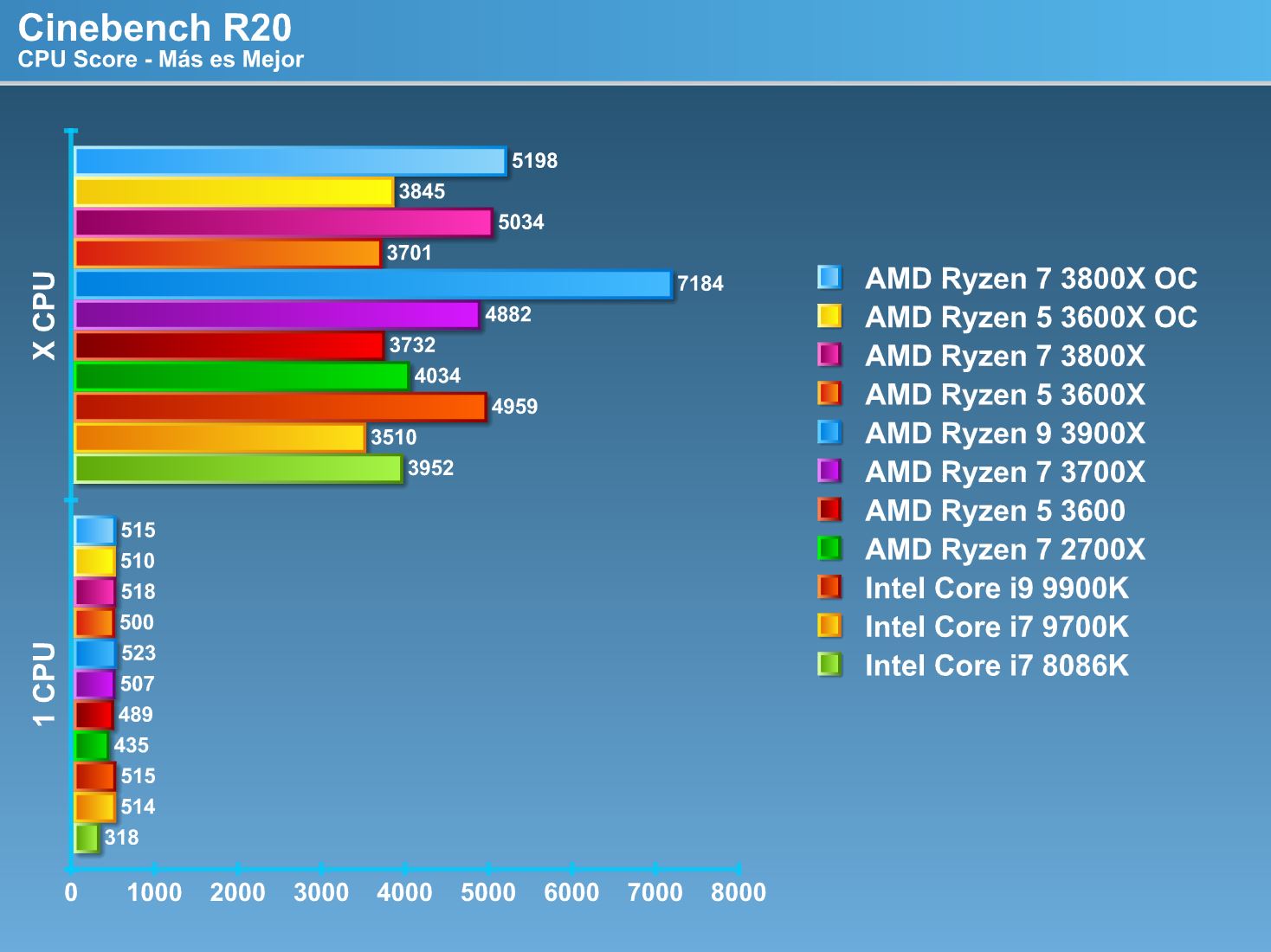
If overclocking in AMD is not something that gives us a great advantage, especially if we use a stock cooling system, however, we can receive a slight boost for those multi-core applications. With better cooling it is likely that we can further stabilize the overclock and deliver about 100 MHz and even 200 MHz more, however AMD Ryzen has not been characterized by increasing its frequency in all its cores.
Conclusion.
Analyzing more models of these Zen 2-based processors, we see how the performance between them is noted with the subtle frequency increases, especially when this is tested under a multi-threaded program. The Ryzen 5 3600X is a fairly capable and balanced processor, with the 6 cores and its 12 threads proves to be an example that can be part of both a gamer and productivity platform, not a butt productivity platform, but if enough to meet a limited demand at low cost.
The Ryzen 7 3800X proves to be a member that can deliver a differentiator in its performance versus its younger brother the Ryzen 7 3700X however it gives a feeling very similar to what happened with the Ryzen 7 1800X and 1700X that felt somewhat redundant models inside of the 8-core segment, although this time the base frequencies of the 3800X and 3700X if they achieve a difference of 300MHz and at its maximum frequency of 100 MHz, giving Ryzen 7 3800X an advantage, so it experiences a TDP that rises to 105W, we must evaluate the choice of one model or another, since the price difference could be around $ 40,000 pesos under the same reseller.
Diversifying its models and managing to find the best product for each segment without exaggerating the number of models is something that AMD has developed very well since AMD Ryzen appeared in the market, targeting compelling models for each segment and without invading the market with models redundant that simply cause madness when choosing a processor, something very different from what Intel has done.
Do we recommend these processors? Totally. And the Why ?, they are able to dominate within the segment for which they were designed, it is the main approach to which we must point in the choice of what we need, however, we must not forget the Ryzen 2000 series that although it has a lower frequency and a manufacturing process greater than Zen 2, continue to deliver a very competitive performance and at a very attractive price. The Ryzen 3000 series provides not only new technology versus 2000 series models but also coexists with the previous models by attacking a larger segment under each of the gaps that existed with the 2000 series, such as the mono-core potential and the rival the Intel Core i9.
Even Zen 2 needs to be polished, we have seen some slight inconveniences in some models that need some small fixes, however AMD Ryzen 3000 has managed to do great damage to the blue side, even with these small mishaps, or imagine what this series will look like totally polished

Thanks.
We must thank PC Factory again for giving us the possibility to test the Ryzen 7 3800X model which has been the rare copy in the series.






